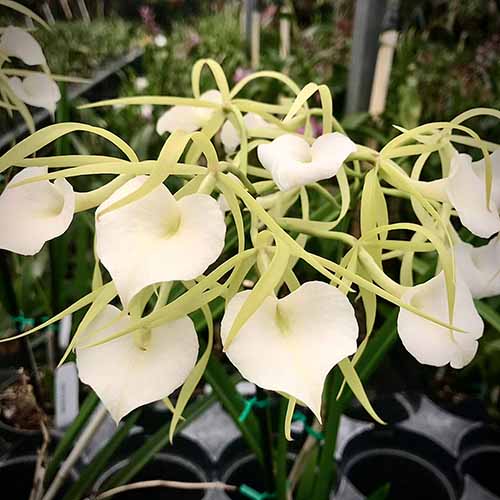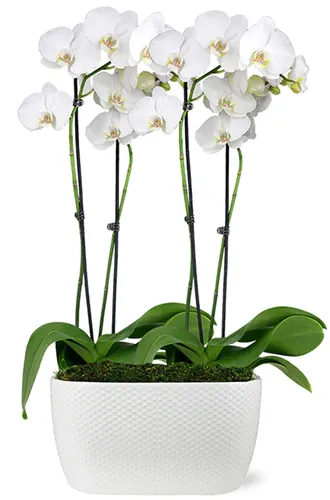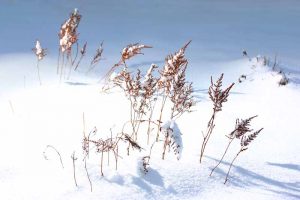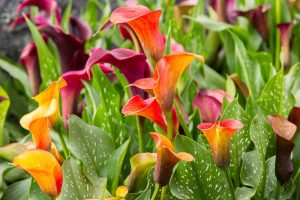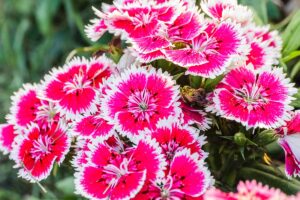Orchids are fascinating plants with incredibly attractive flowers. The blooms appear in a myriad of colors, shapes, and patterns on plants with many different foliage types.
And luckily for those of us without the luxury of having a greenhouse in our backyards, there are many different types of orchids that can be grown indoors as houseplants – making it entirely possible to find the one that is our perfect match!
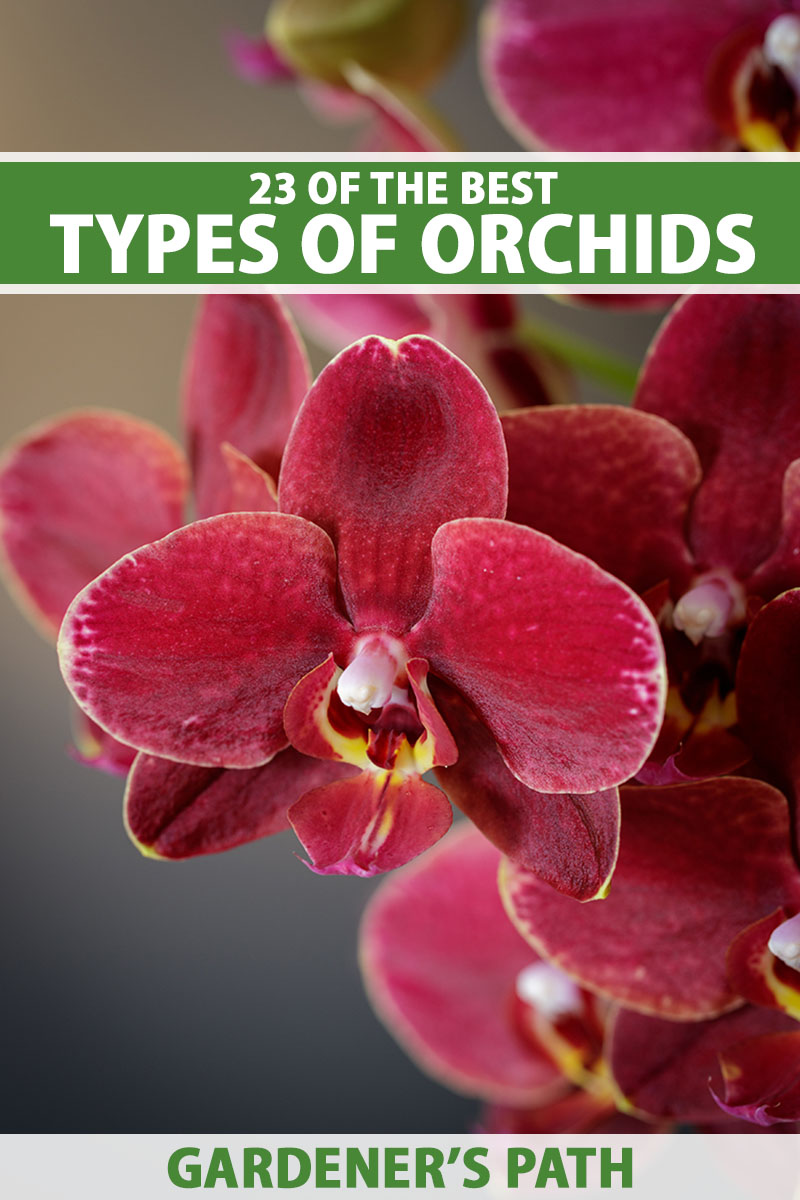
We link to vendors to help you find relevant products. If you buy from one of our links, we may earn a commission.
We’re going to get up close and personal with a mere handful of the many different types of orchids that exist in the world.
You’ll learn about 23 different types of orchids – a small sampling from the more than 700 genera in the Orchidaceae family! – as well as particular species or hybrids from each genus that you may enjoy growing at home.
As you read through this guide, I’ll let you know what to expect in terms of the flowers and plant growth. And I bet at least a few candidates will beguile you with their extraordinary good looks and charming demeanors.
But I’m not going to tempt you with exciting options only for you to be disappointed when your floral indulgences wither in growing conditions ill-suited to their needs.
That’s why I will also provide you with the basic cultural requirements for each of these selections.
Then you can narrow down your shortlist to the plant or plants whose light, humidity, and water needs are a great fit for both your care-taking style and the conditions available in your home.
Ready to find your orchid match? Here’s a quick peek at the varieties we’ll cover up ahead, organized alphabetically by genus name:
One of the important features you’ll learn about each of these selections is whether they are considered warm, intermediate, or cool growers, giving you an indication as to what type of temperature ranges they will need in order to prosper.
Here’s a quick snapshot of the temperature needs for these different categories:
- Warm growers prefer daytime temperatures of 70-90°F, and 60-75°F at night.
- Intermediate growers need daytime temperatures of 65-80°F, with nighttime temperatures of 55-70°F.
- Cool growers thrive in daytime temperatures of 60-75°F, and a nighttime range of 50-65°F.
To learn more about these differences, as well as basic care requirements for these flowering plants, be sure to read our complete guide to growing and caring for orchids.
And one more note before we get started – if botanical names for species are something you are no stranger to, but orchids are a topic you are just starting to explore, you’ll notice that the way species are abbreviated is a bit different for orchids, as well as the way hybrids are described.
To avoid confusion, common genus abbreviations here may include two or more letters rather than one.
And hybrid cultivar names include the species and genus followed by the hybrid name, and then the cultivar name in single quotes.
1. Brassavola
Orchid blossoms are known for their prominent lips (a specialized lower petal), and our first selection takes this feature to the extreme.
Brassavola is a genus that contains approximately 20 species. These are native to tropical areas of Central America, South America, and the West Indies.
Epiphytes and lithophytes, Brassavola species are sympodial and have cylindrical leaves and pseudobulbs, the latter of which help to store water. These fleshy leaves tend to be long and tapering. They’re usually green in color, and are sometimes speckled with red.
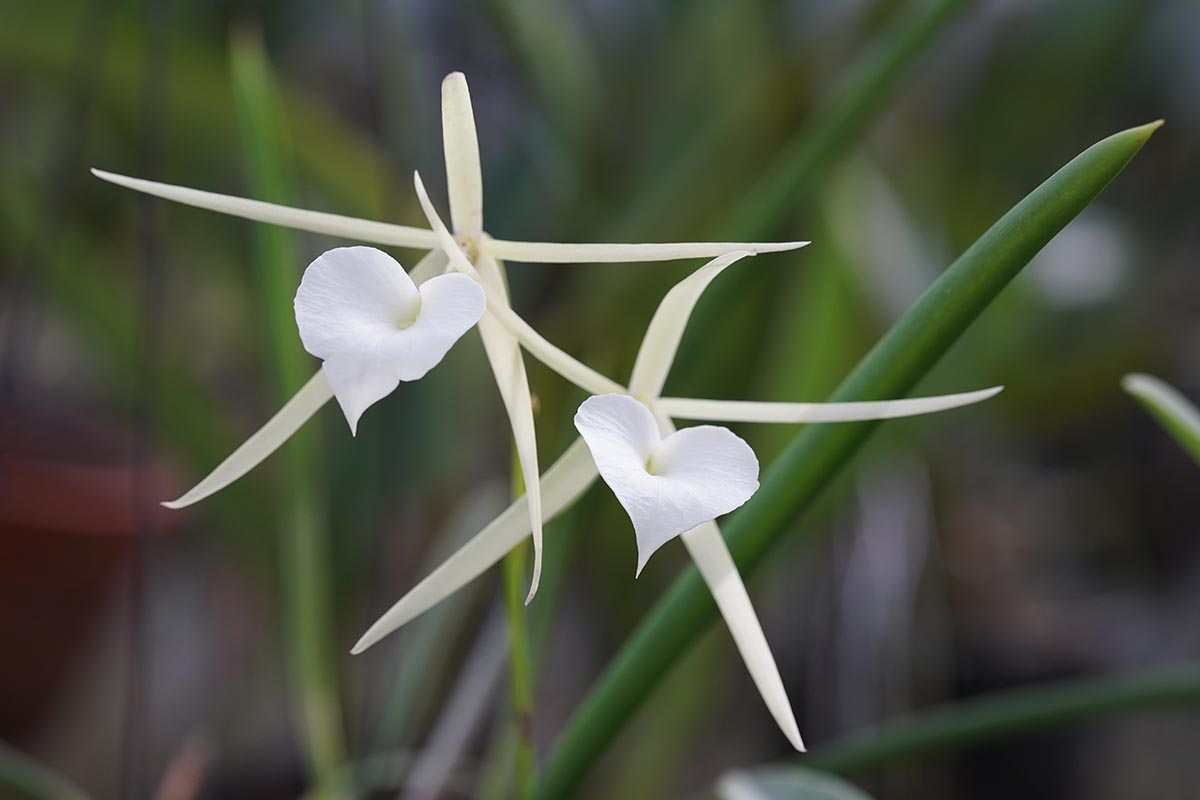
Brassavola plants have a pendant growth habit and produce blooms in shades of white and greenish white, a common feature of flowers pollinated at night by moths.
Blooms are showy with large, ruffled or lobed lips, blooming primarily during the summer, and they are fragrant at night.
Brassavolas require bright light and while this can be primarily indirect light, they will appreciate a few hours of direct sunlight each day.
These orchids are warm to intermediate growers and are much more tolerant of low humidity levels than most of our other selections, requiring levels of only 30 to 50 percent.
Specimens can be mounted, which is a common way to grow epiphytes. They can also be cultivated in baskets, or in pots if the potting medium has excellent drainage.
Potted specimens need to dry out between waterings, while those in baskets or mounted are usually watered by soaking them for 15 minutes about once a week.
Brassavolas are easy to cultivate as houseplants, and it’s easy to get these orchids to rebloom, making them great choices for beginning orchid growers.
One selection in this genus you might want to start with is B. Little Stars, an interspecies cross of B. nodosa and B. cordata that bears wonderfully fragrant flowers. Blooms have large, white, heart-shaped lips with light green petals and sepals.
Live Near-Blooming-Size Brassavola Little Stars
You can purchase a B. Little Stars plant up to 18 inches tall with a 12-inch spread from Clear Pots via Walmart.
2. Brassia
If I asked you to think of a stereotypical flower, I’m guessing something rounded would come to mind, such as the shape of a rose or daisy.
But the floral world is full of wispy options as well, and that’s what you’ll find with this selection.
Native to tropical areas in the Americas, the Brassia genus includes 68 species, most of which are epiphytes, with a few terrestrial species as well.
Also known as “spider orchids,” these sympodial species have flattened, green pseudobulbs which often have a reddish tint.
Leaves are yellowish green, and linear to oblong or strap shaped, on plants that range in size from small to large.
Plants produce multiple fragrant blooms on arching spikes, usually in shades of green, yellow, or tan.
These flowers have thin, wispy petals, and depending on the species or hybrid, they vary in size, with some being quite large.
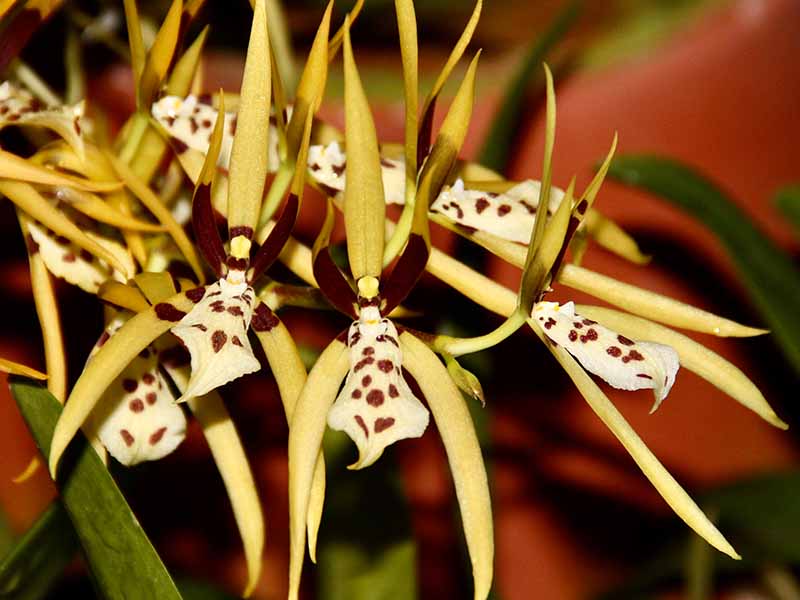
Brassias tend to bloom in spring or summer, and sometimes produce flowers more than once a year.
Brassias are cool, intermediate, or warm growers depending on the species or hybrid and require humidity levels between 50 and 70 percent.
They generally need bright, filtered light and can be grown in lightly shaded, south-facing windowsills.
Brassias can easily be grown by beginners, and can be cultivated either in pots filled with an orchid-growing medium or mounted.
For specimens living in pots, plan to water when the surface of the potting medium is dry to the touch – approximately once a week from spring through autumn, and less frequently during winter.
For mounted specimens, they will likely need to be watered about every other day.
If you’re looking for a Brassia to start with, Brs. verrucosa is one species you may want to consider.
It bears sprays of 10 to 20 light green to yellow blooms speckled with reddish-brown flecks and its long, thin petals and sepals give the flowers a spider-like appearance.
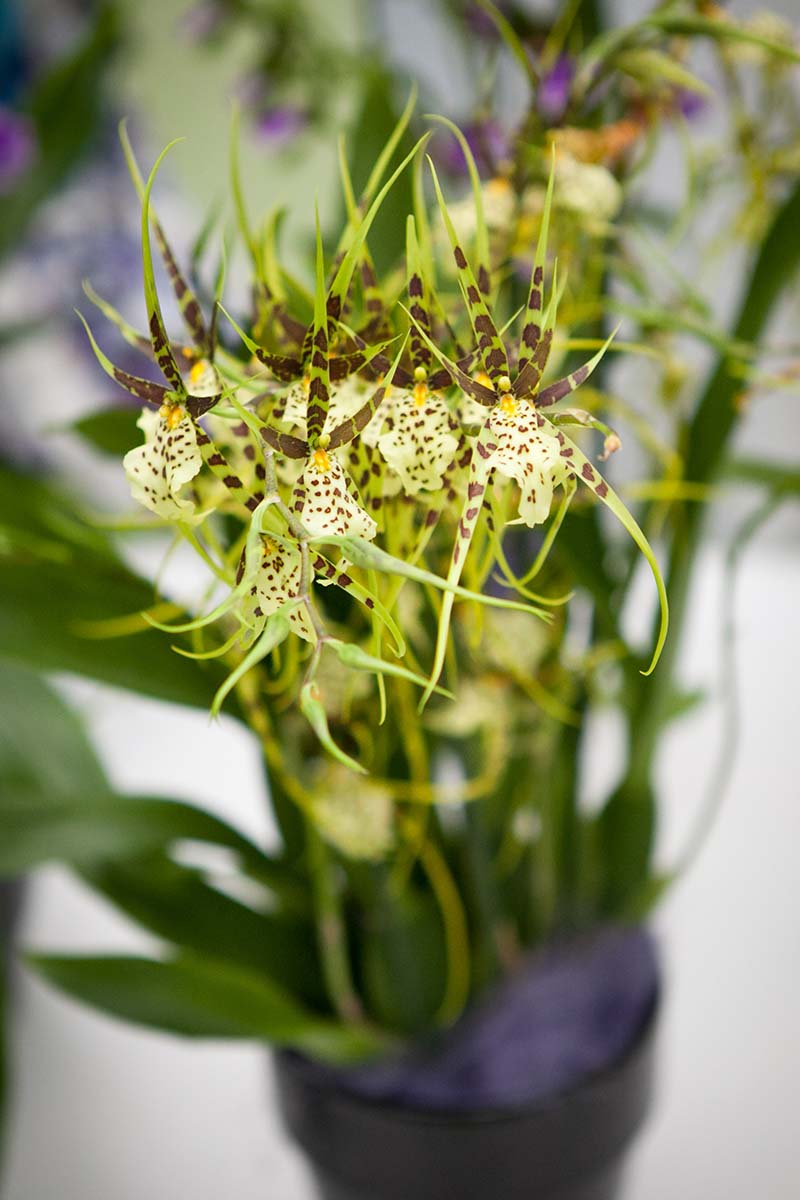
Brs. verrucosa is an intermediate grower that requires low to medium light, and whose fragrant and very large, eight- to 10-inch flowers bloom between spring and fall, lasting up to eight weeks long.
3. Bulbophyllum
Are you already familiar with some of the most common orchid houseplants but you still feel the tug to search out something different? You’ll discover some surprising options among the sympodial plants in this genus.
Bulbophyllum is a very large genus, containing over 2,000 species of orchids that are native to tropical and subtropical areas in Asia, Oceania, Africa, and the Americas.
Though some are lithophytes, most Bulbophyllum species are epiphytes. They have pseudobulbs for storing water, and their slightly cupped leaves can be thin, leathery, or fleshy.
Bulbophyllum species have light green or medium green foliage, and this genus includes both evergreen and deciduous plants.
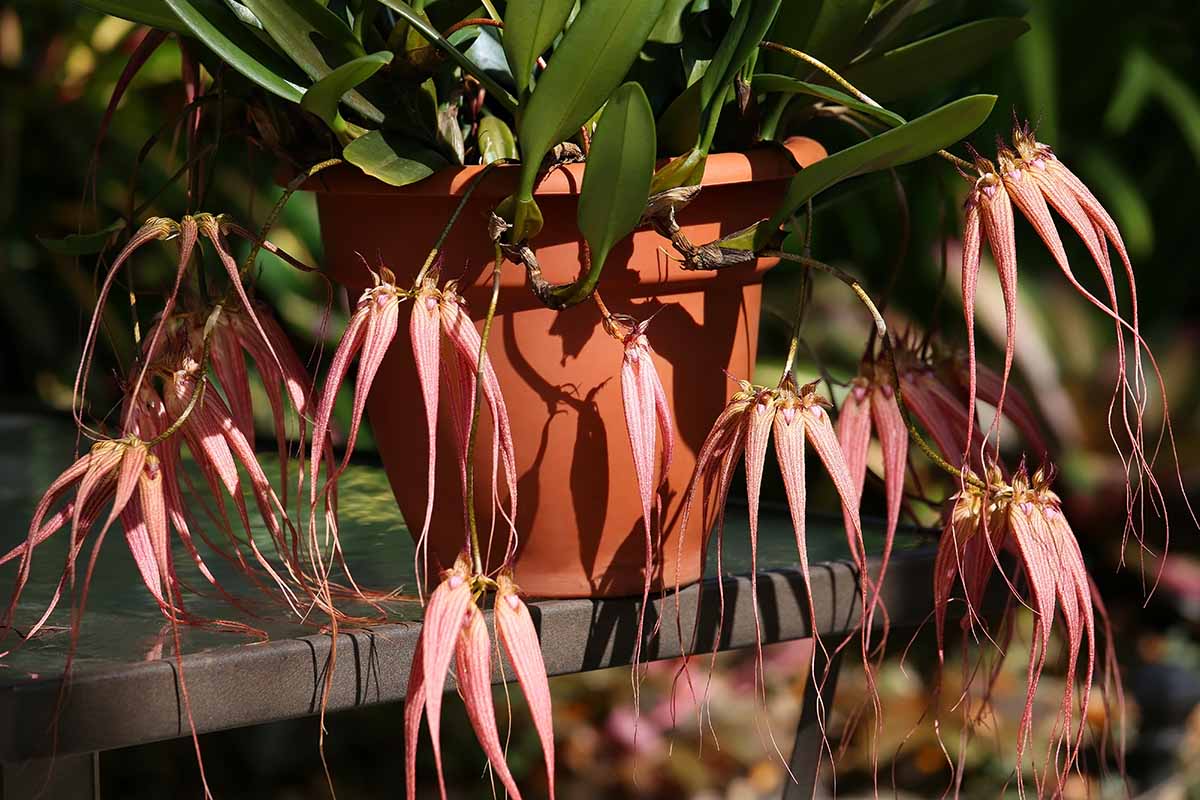
With so many different species, this genus displays a lot of diversity – some of its members have flowers easily recognizable as orchids, while others are surprisingly un-flowerlike in their appearance.
Plants range in size from very small to very large, and while many of these species have fragrant blooms, some have an unpleasant odor that is intended to attract their main pollinators – flies.
Most of these orchids are intermediate growers, though some are warm growers, and others prefer cool conditions.
These species tend to thrive in moderate to bright indirect light.
Some species can be cultivated in shallow pots, while those with long rhizomes tend to fare better in baskets or mounted on slabs. Fast growers, the roots of these orchids can be difficult to contain.
Bulbophyllums require humidity in the 50 to 70 percent range and tend to be quite thirsty, with mounted specimens usually requiring daily watering and potted ones needing to be watered a few times a week.
Some of them require a period of winter rest with either less water or none at all.
Bulbophyllums may be a bit tricky, so if you’re a newbie orchidophile, you may want to hone your chops on some of the other, beginner-friendly genera recommended in this article instead.
For intermediate and advanced orchid fans, if you’re ready to give cultivating the surprising blossoms of bulbophyllums a go, Bulb. Frank Smith is a hybrid you might want to consider.
Bulb. Frank Smith is an interspecies cross of Bulb. lobbii and Bulb. carunculatum. It bears star-shaped blooms that have yellow sepals and petals tinged with orange, and a deep red, small, tongue-shaped lip.

Live Bulbophyllum Frank Smith in 2” Pot
You can purchase a live Bulb. Frank Smith specimen in a two-inch pot from Aloha Hawaii Orchids at Amazon.
4. Calanthe
With blooms shaped like birds or butterflies paused mid-flight, this next option will wow you with surprising color combinations.
Calanthe is a genus of mostly terrestrial species, which was expanded in 2020 to incorporate a few other re-classified genera, including the genus Phaius.
This genus now includes 275 sympodial species native to tropical and subtropical areas of Africa, Asia, the Americas, and Oceania.
These plants are divided into two types: those that are deciduous, and those that are evergreen.
The evergreen calanthes have no pseudobulbs, while those that are deciduous have prominent ones. Both types produce large, pleated leaves.
Flower spikes typically appear in winter, with blooms in shades of white, orange, brown, yellow, pink, purple, or blueish purple, lasting a month or longer.
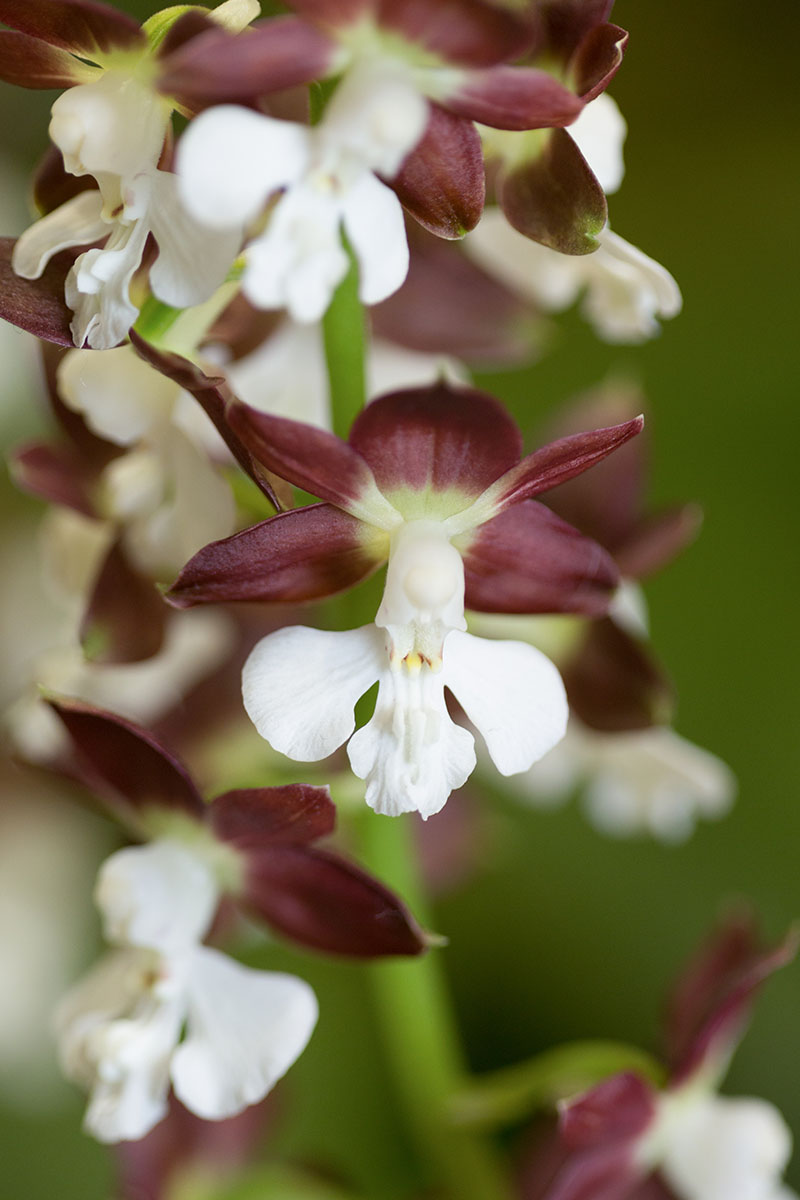
Here are a few tips for caring for calanthes:
Depending on the species or hybrid, a calanthe can be a cool, intermediate, or warm grower. All will thrive with bright, indirect light.
Evergreen species require a consistently moist potting medium year round while deciduous types should receive less water during winter dormancy, only enough to keep the pseudobulbs from shriveling.
Newbie orchid fanatics will no doubt have an easier time with an evergreen calanthe, waiting to gain some experience before moving on to the deciduous types.
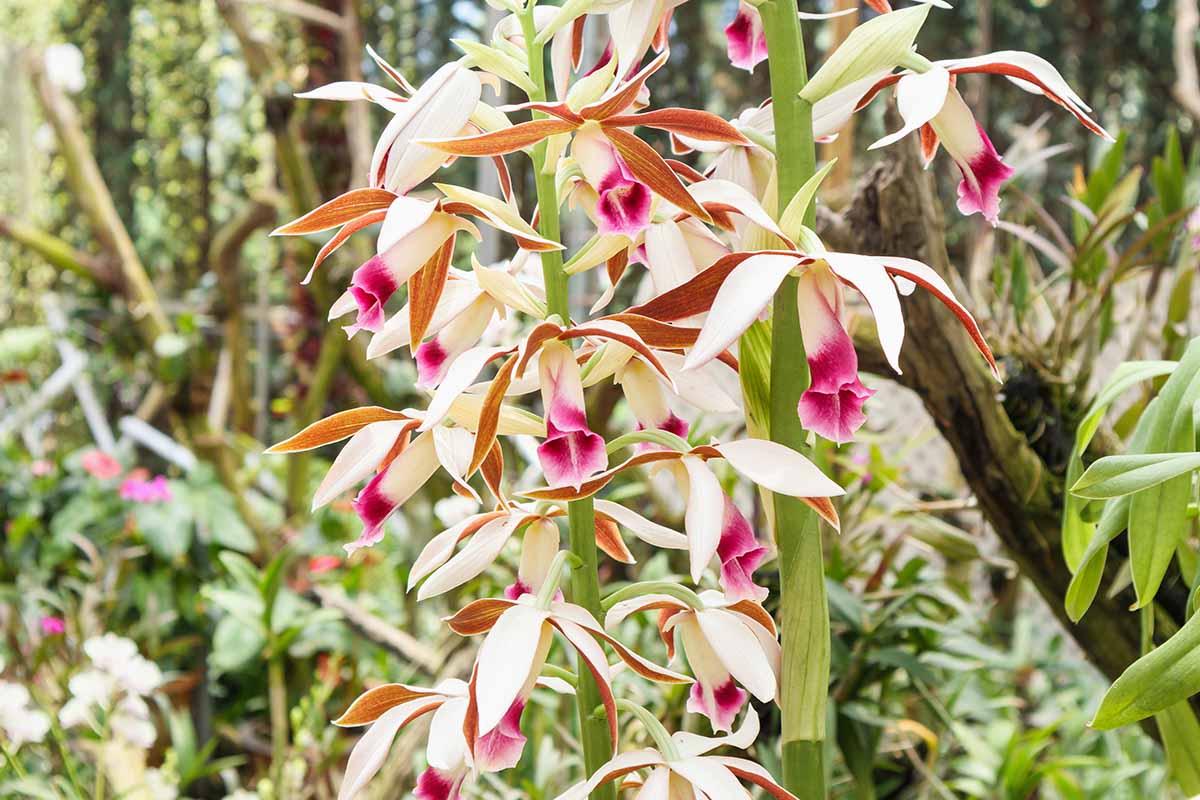
One to start with is Cal. tankervilleae, also known as the “greater swamp orchid.” This is an evergreen, terrestrial, warm growing species that flowers in spring or early summer.
The petals of this species’ blooms are white on the outside, and brownish purple on the inside, surrounding a tubular purple lip.
5. Cattleya
Does your aesthetic tend towards ruffles and Rococo artwork? If so, you may find the ornate blooms of these orchids particularly pleasing.
In addition to natural hybrids and many horticultural hybrids, there are over 120 species in the Cattleya genus, originating primarily from South America.
Known for their use by florists as cut flowers and in corsages, cattleyas are epiphytic or lithophytic plants which produce pseudobulbs and are sympodial.
Want to learn more about orchid terms like “pseudobulbs” and “sympodial”?
Be sure to read our article on different categories of orchids (coming soon!) to understand common terminology and learn more about the ways these plants are categorized based on their various features.
Cattleya leaves are medium green, thick, leathery, and usually oblong. Plants typically reach up to two feet tall, with hybrids being more compact.
These can be divided into two different types – “unifoliate” species that have one leaf per pseudobulb, and “bifoliate” species that have two.
Unifoliate cattleyas tend to produce flowers in shades of violet, lavender, or white, while bifoliate cattleyas usually feature blooms in mahogany, purple, green, yellow, or orange hues.
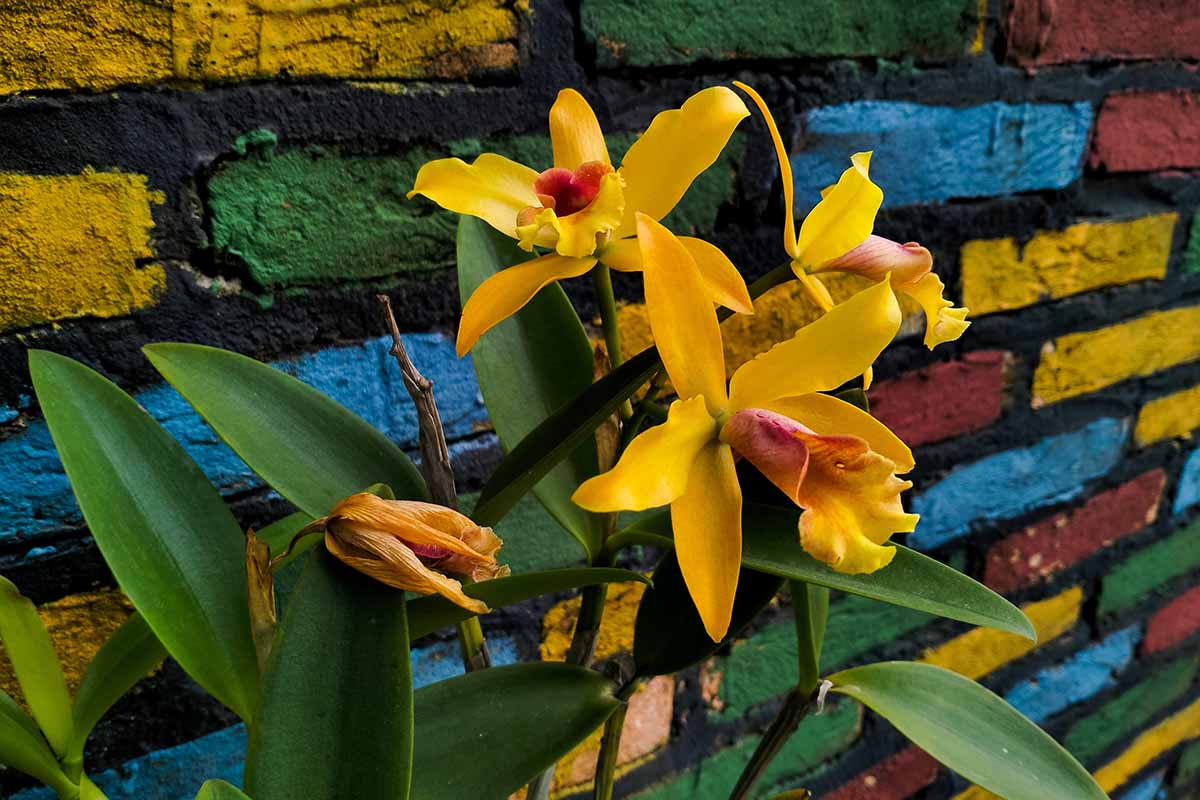
Cattleya blooms are typically fragrant, large, showy, and funnel shaped, with large ruffled lips.
As for caring for cattleya orchids, first it’s important to know that they are primarily intermediate growers, with some species and hybrids that are considered warm growers.
The best general temperature range for these orchids is 70 to 85°F during the day, with nights at 55 to 60°F. They can tolerate higher daytime temperatures when provided with more shade.
Speaking of light – cattleyas appreciate bright light, and do well when they receive a few hours of direct sunlight in the morning or late afternoon, but not at midday.
When it comes to humidity, a range of 40 to 80 percent is what they’ll need.
Cattleyas should be allowed to dry almost completely between watering. Young plants and mini varieties need to be watered more frequently than larger varieties or more mature specimens.
In addition, these orchids should be watered less while undergoing a cool rest period in the winter, otherwise their roots can rot.
Cattleyas can be cultivated in pots or baskets, or they can be mounted on wood or cork.
There are a wide range of cattleyas requiring different expertise levels for successful cultivation. Some are great for beginners, while others are best left to intermediate or advanced orchidophiles.
And when it comes to choosing a cattleya, keep in mind that hybrids tend to do better as houseplants than species plants.
One cattleya cultivar you might want to start with is C. Potinara Chief ‘Sweet Orange.’
This compact grower produces fiery-colored, fragrant flowers that are medium-sized, measuring three and a half inches wide.
Live Blooming Size Cattleya Potinara Chief ‘Sweet Orange’
You can purchase a live, blooming-size Potinara Chief ‘Sweet Orange’ cattleya in a four-inch pot from The Orchid Gallery via Amazon.
Find more tips on cattleya care here.
6. Coelogyne
When many of us think of orchids, we imagine a flower spike graced with a single, striking, large bloom, or perhaps a few large flowers.
If that’s the case for you as well, some of the members of the Coelogyne genus (pronounced “see lodge eh nee”) will have you rethinking this common perception!
Many species in this genus make a big visual impression with trailing flower spikes thickly covered with clusters of small blooms, particularly those previously classified as Dendrochilum species, until they were reclassified in 2021.
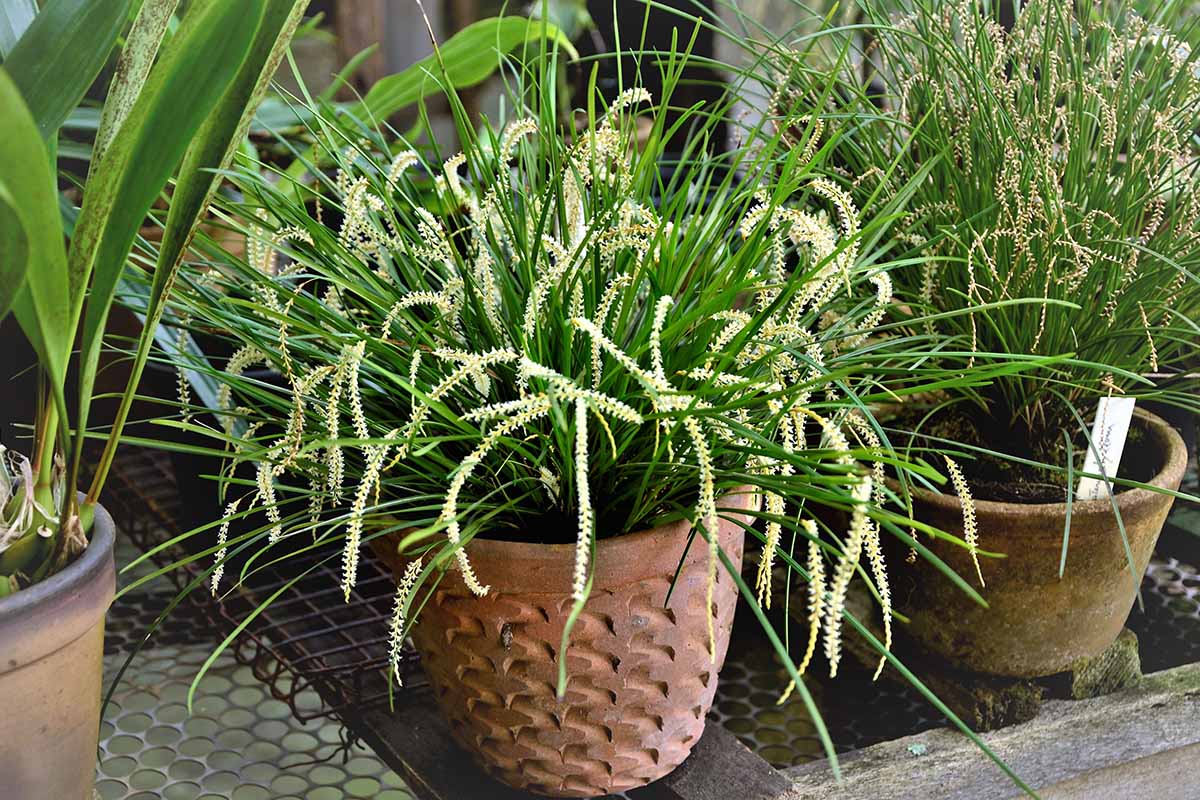
Those formerly known as dendrochilums are commonly called “golden chain orchids” or “fox brush orchids,” in reference to their dense flower sprays. Blooms tend to be white, tan, or green in color.
The Coelogyne genus contains over 595 species from India, New Guinea, and Southeast Asia.
These sympodial orchids are mostly epiphytes, and feature pseudobulbs that are usually oval shaped.
Most coelogynes are intermediate growers that thrive in medium to bright, indirect light. In summer their humidity needs are high – about 85 percent – while in winter humidity should be decreased to between 60 and 70 percent.
They should be watered when their potting medium starts to dry out, but before it has dried completely. These orchids also require a short winter rest period, with less frequent irrigation.
Coelogynes are grown in pots, and they are considered easy to cultivate, even for beginners.
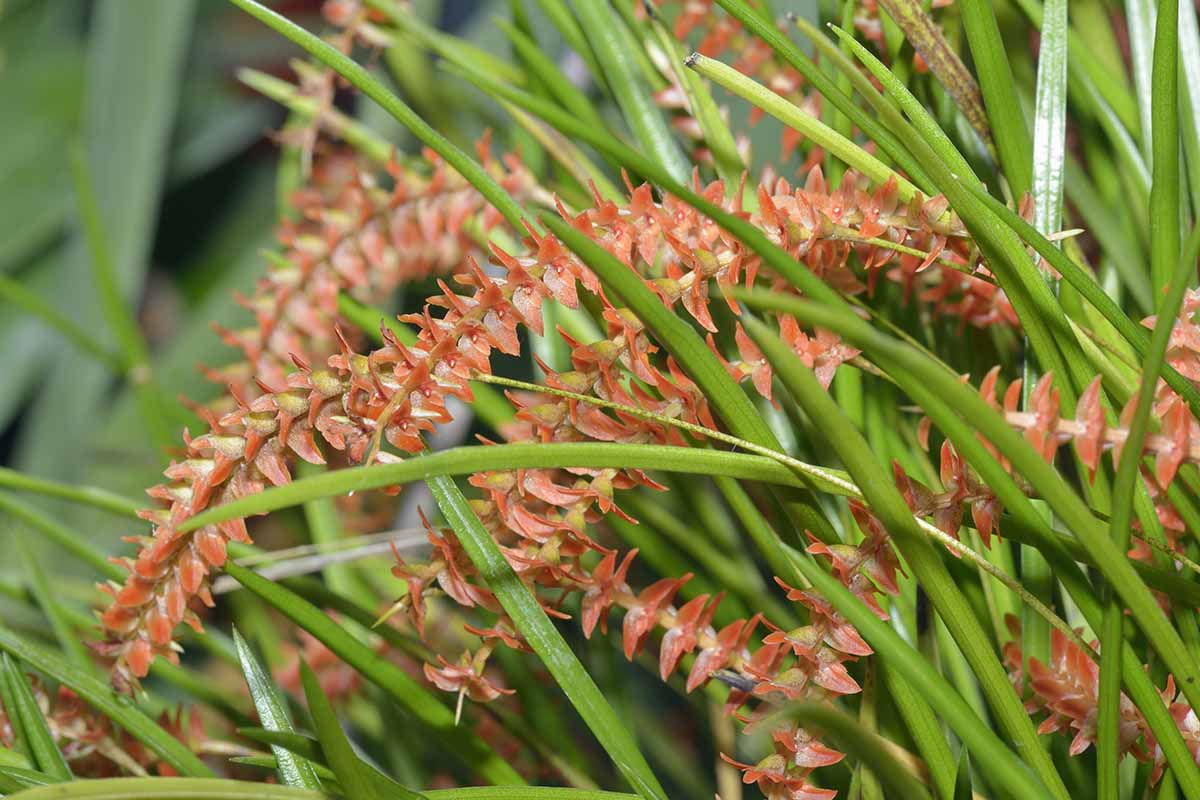
If you’re looking for a starter plant, try Coel. wenzelii, an epiphyte that produces reddish-orange flowers in winter and thrives in warm conditions in low or medium, indirect light.
7. Cycnoches
If you’re the type of person who often sees faces in your food or a parade of animals in the clouds, the blooms on this selection might tickle your fancy.
Known as “swan orchids” in reference to the shapes of their flowers, the 33 species of the Cycnoches genus are native to Central and South America.
These sympodial plants produce pseudobulbs that are conical or spindle shaped. Plants maintain only three pseudobulbs at a time, with the oldest dying back when a new one is produced.
Swan orchids are deciduous, with leaves that are pleated and thin.
The leaves drop after flowering, leaving only the pseudobulbs behind, which makes a Cycnoches specimen look more like a cactus than what you might expect from an orchid plant.
Cycnoches produce pendulous sprays of flowers that are very fragrant and tend to come in shades of red, bronze, white, yellow, or green. Blooms are usually produced in fall, with flower size varying depending on the species or hybrid.
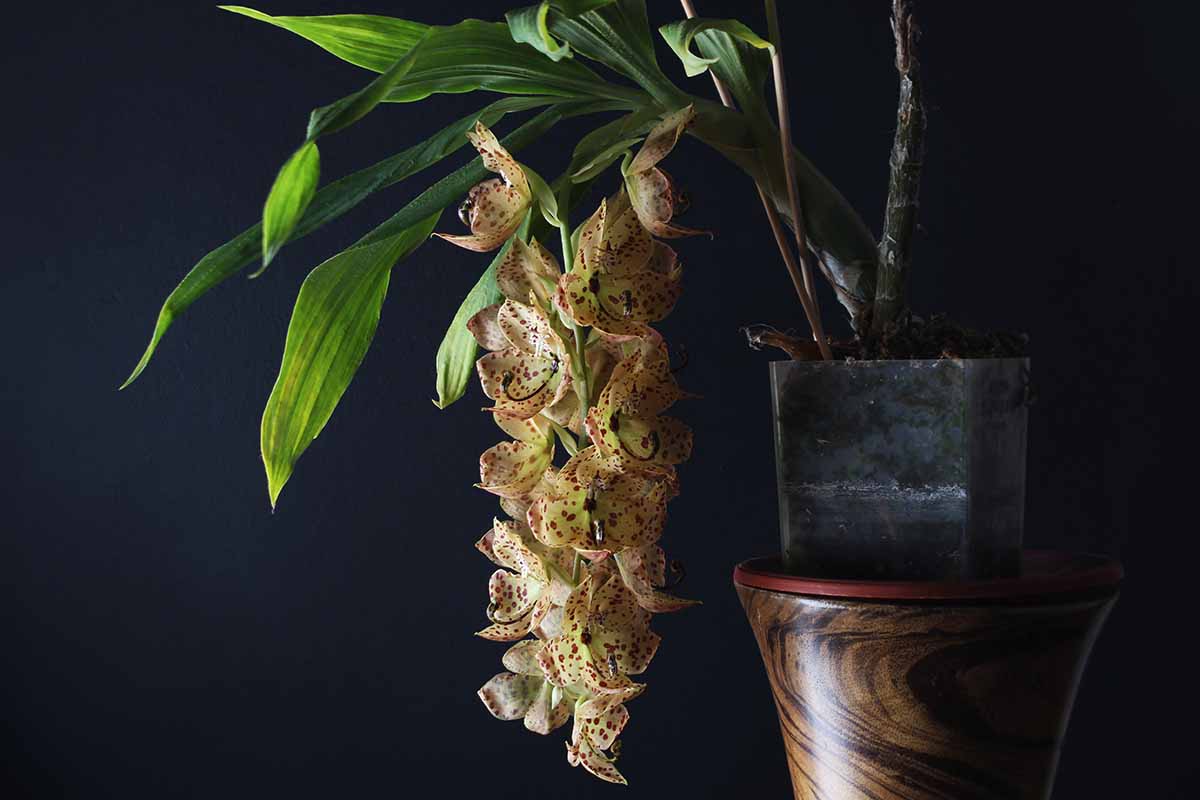
Swan orchids should be treated as warm growers from spring through autumn and intermediates during winter.
Provide bright, indirect light, with some direct sun in the morning.
Since they are deciduous, cycnoches orchids have changing water needs throughout the year, requiring lots of water during the growing season, followed by a drier rest season.
Cycnoches thrive with humidity levels in the range of 50 to 70 percent, and can be cultivated in pots or mounted.
Because of their deciduous natures, cycnoches may be best reserved for intermediate and advanced hobbyists. Once you’re ready, though, an excellent species to start with is Cyc. warscewiczii.
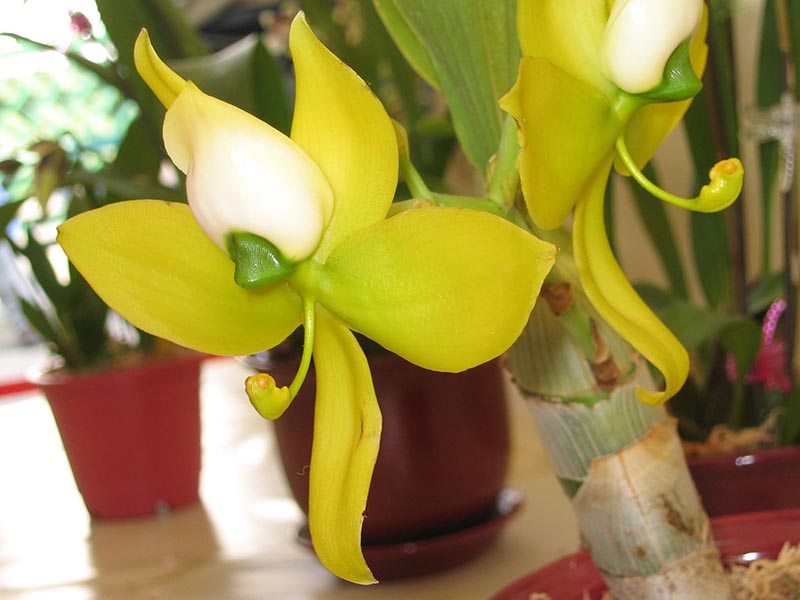
With upside-down, fragrant flowers, this species has greenish-yellow petals and sepals surrounding a white lip.
8. Cymbidium
With different bloom types to please practically everyone, these types of orchids could easily find a spot in nearly any home.
Cymbidiums are native to tropical and subtropical areas of Asia and Australia, and are commonly known as “boat orchids” in reference to the shape of the flowers’ lip.
The Cymbidium genus contains approximately 85 species, consisting of sympodial epiphytes, lithophytes, and terrestrial species. There are also many hybrids, as well as some mini hybrids.
Cymbidiums produce grass-like or strap-shaped leaves that are medium green to golden green in color, which in most species are produced from elongated or oval-shaped pseudobulbs. Plants can be compact or large, reaching up to three feet tall.
Blooms of this genus are diverse, with some producing small flowers, and others large ones.
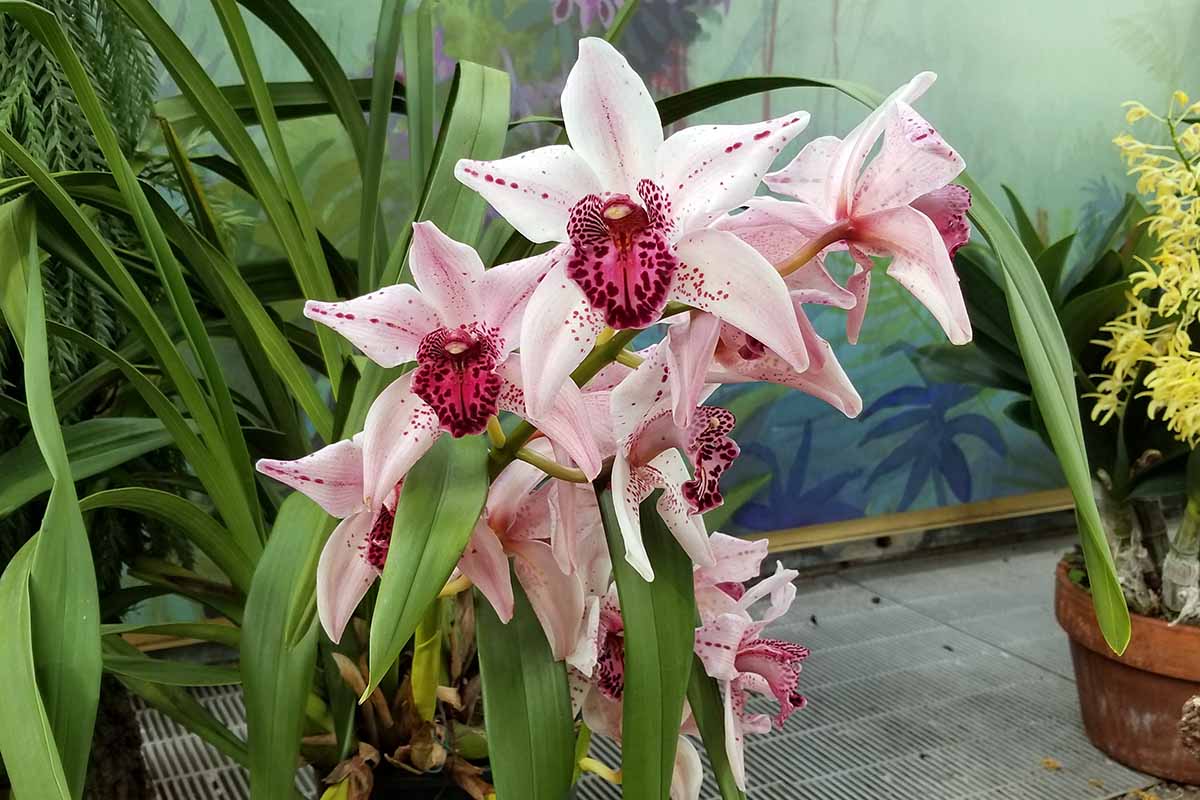
Some blooms are scented, typically in shades of white, yellow, green, pink, and red.
Here’s what you’ll need to know about caring for cymbidiums:
Large-flowered types are cool growers, while small-flowered tropical and subtropical types prefer warm conditions. There are also some small-flowered terrestrials from temperate climates that prefer cool, moist conditions.
However, most cymbidiums can be treated as intermediate growers if you aren’t sure what type you have.
As for light, cymbidiums thrive in bright, direct light, though direct sun at midday should be avoided.
The growing medium should be kept moist, watering when the top inch or two is dry, and these plants should be kept in a humidity range of 40 to 70 percent.
While these orchids can be cultivated in pots, baskets tend to work better for specimens with trailing inflorescences.
Cymbidiums are good for beginners – and a good one to start with is Cym. Sarah Jane ‘Ice Cascade.’
This hybrid is a warm grower that doesn’t require cooler winter temperatures. Its white blooms appear in the summer or fall, last for around a month, and are very fragrant.

Live Cymbidium Sarah Jane ‘Ice Cascade’
You can purchase a live Sarah Jane ‘Ice Cascade’ cymbidium in a three-and-a-half-inch pot from Orchid Insanity via Amazon. This specimen will bloom in 12 to 18 months with proper care.
9. Dendrobium
It seems that this next type of orchid may have written the book on adapting to different habitats, giving us a wealth of options in terms of both cultural requirements and blooms.
Dendrobium is an extremely diverse genus containing at least 1,600 different species, whose native habitats range throughout Asia and Australia.
These sympodial orchids bear blooms that are small or large, with some lasting just a few days and others lasting for weeks, depending on the species or hybrid.
Some dendrobiums are suitable for beginner hobbyists while others are best left to more advanced orchidophiles.
Native to a large variety of different habitats, it is impossible to succinctly generalize about either growth characteristics or care for plants in this genus – you can explore these plants further in our guide to cultivating and caring for dendrobiums. (coming soon!)
For the purposes of this article, we will instead provide you with some appetite-whetting info on just one species that is easy to find and cultivate – Den. kingianum.
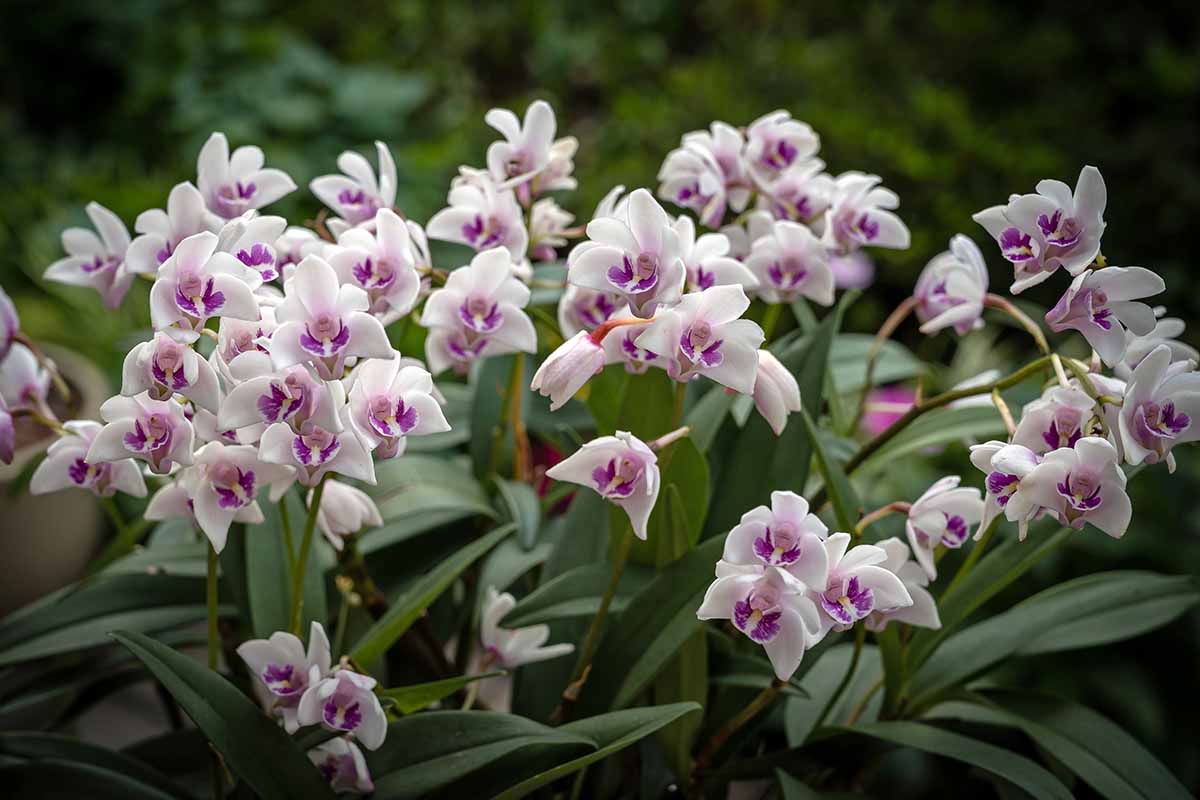
Den. kingianum is one of the most easy-care dendrobiums you can keep as a houseplant. Also known as “pink rock orchid,” this lithophyte is highly adaptable to both chilly temperatures and extreme heat.
For best results, however, treat it like a cool grower, provide it with bright indirect light, provide at least 50 percent humidity, and water when the potting medium starts to dry out.
A cool period in late fall with reduced water will promote flower production.
There are many different forms and cultivars of this species, with flower colors in shades of white, pink, mauve, purple, and yellow. Blooms are long-lasting and fragrant on compact plants.

Live Blooming Size Dendrobium Kingianum Plant
You can purchase a live, blooming-size Den. kingianum plant from Orchid Insanity via Amazon.
10. Encyclia
Our next selection also brings with it a high level of diversity, yet has cultivation requirements that are easy to master.
Encyclia orchids are epiphytes, with natural habitats that range from hot, dry areas to misty rainforests.
With approximately 171 species from Mexico, Central America, South America, and the West Indies, these range in size from just two inches tall to over two feet in height.
These sympodial plants produce fleshy, strap-like leaves from their pseudobulbs and tend to bear flowers in shades of green, brown, maroon, or white.
Usually a dozen or more blooms are produced on each flower spike, with individual blooms that are one to two inches wide.

Encyclias are mostly intermediate to warm growers, with some preferring cool conditions. They require good air circulation, and bright to very bright, filtered light.
These should be allowed to dry out between waterings. They need drier conditions in winter, but watering should be increased when plants are putting on new growth.
As for humidity requirements, encyclias require only moderate humidity of 40 to 70 percent, preferring slightly higher levels during the growing season than during winter.
These orchids can be cultivated in small clay or plastic pots, or they can be mounted, and they are excellent for beginning growers.
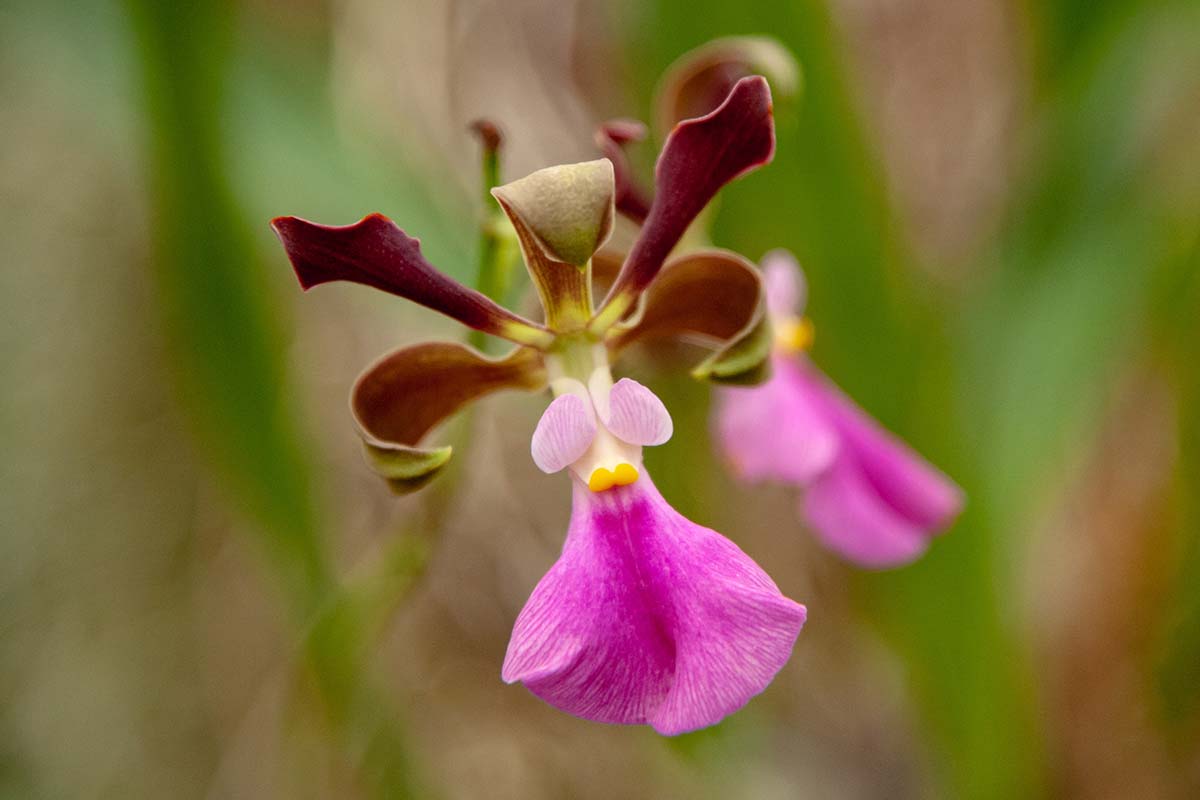
E. cordigera is one you might choose to start with. It produces fragrant blooms that last for up to three months.
There are many different cultivars of E. cordigera, displaying combinations of dark mahogany petals and sepals with a white, pink, or purple lip.
11. Epidendrum
If it seemed like Dendrobiums were a diverse bunch, meet Epidendrum, a genus that includes over 1,700 species. These plants follow the trend of our last two selections in their natural history of adapting to diverse habitats.
Also called “crucifix orchids,” this extremely varied genus includes species native to Central America, Mexico, South America, and the United States.
These sympodial plants are epiphytic or terrestrial, and the genus Epidendrum includes both miniature species and giants that reach six feet tall, as well as many sizes in between.
Most epidendrums produce cane-like pseudobulbs or reedlike stems.
Although blooms are long-lasting and often red, magenta, orange, or green, these may bear flowers in all colors of the spectrum except for black and cyan blue.
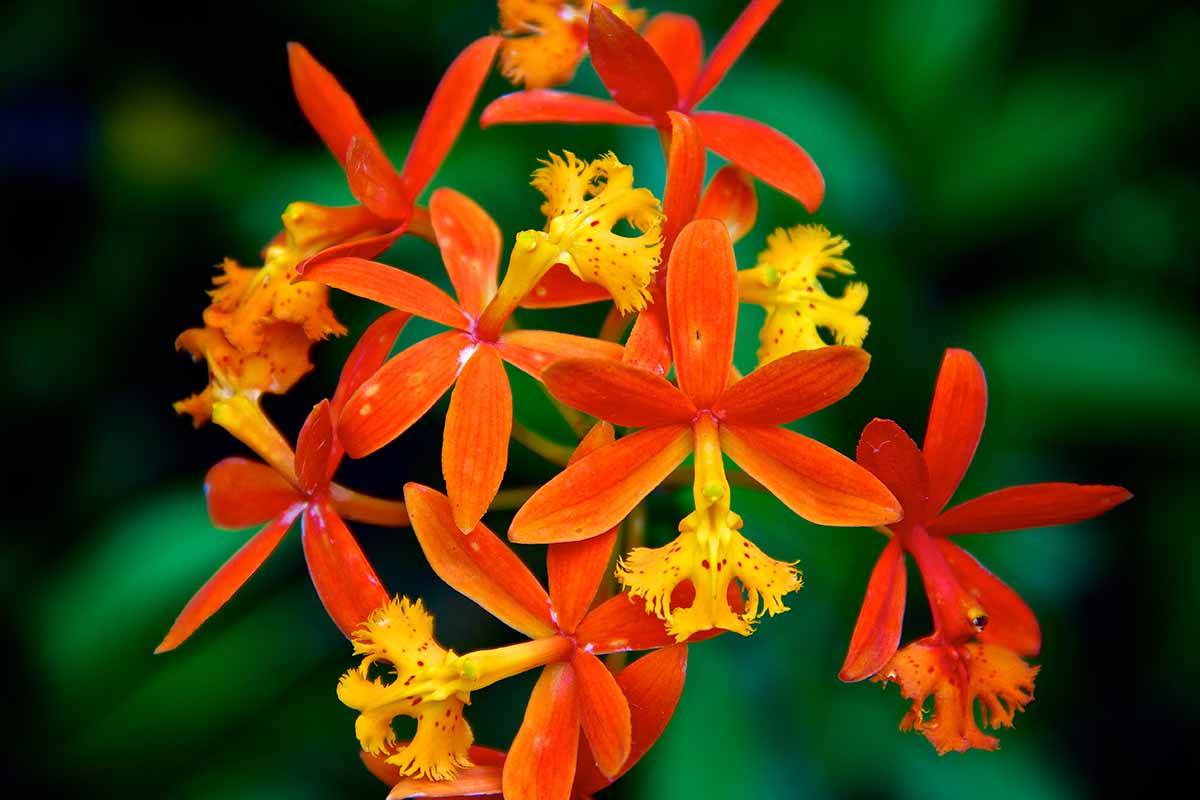
When it comes to growing epidendrums, most prefer intermediate temperatures, while some prefer cool or warm conditions, depending on the species.
They require bright light, a humidity range of 50 to 80 percent, and should be allowed to dry out completely between waterings.
Epidendrums are evergreen and continue growing throughout the year, but some do prefer a rest period with cooler, drier conditions in the winter.
Crucifix orchids can be cultivated in pots filled with a coarse potting medium, but smaller specimens can also be mounted.
Raising epidendrums is straightforward enough for even beginning orchid growers.
Since your choices are numerous, here’s a suggestion to start with: Also known as “fire star orchid” or “poor man’s orchid,” Epi. radicans is a type of terrestrial orchid that has reedlike stems and fiery, dark reddish-orange and yellow blooms.
Epi. radicans prefers warm temperatures, and should be watered approximately once a week.

Live Epidendrum Radicans Plant in 4” Pot
You can purchase a live Epi. radicans orchid in a four-inch pot from the Emerald Goddess Gardens Store via Amazon.
12. Laelia
If you’re looking for a star of an orchid that will join you in getting some good rest during the winter months, you’ll love this next selection.
The Laelia genus is made up of 24 species from Mexico, the West Indies, and Central and South America.
These sympodial epiphytic and lithophytic plants feature pseudobulbs and leathery or fleshy leaves, which sometimes have a purplish tint.
Laelias are known for their star-shaped blooms and bold colors, though white and purple flowers are the most common.
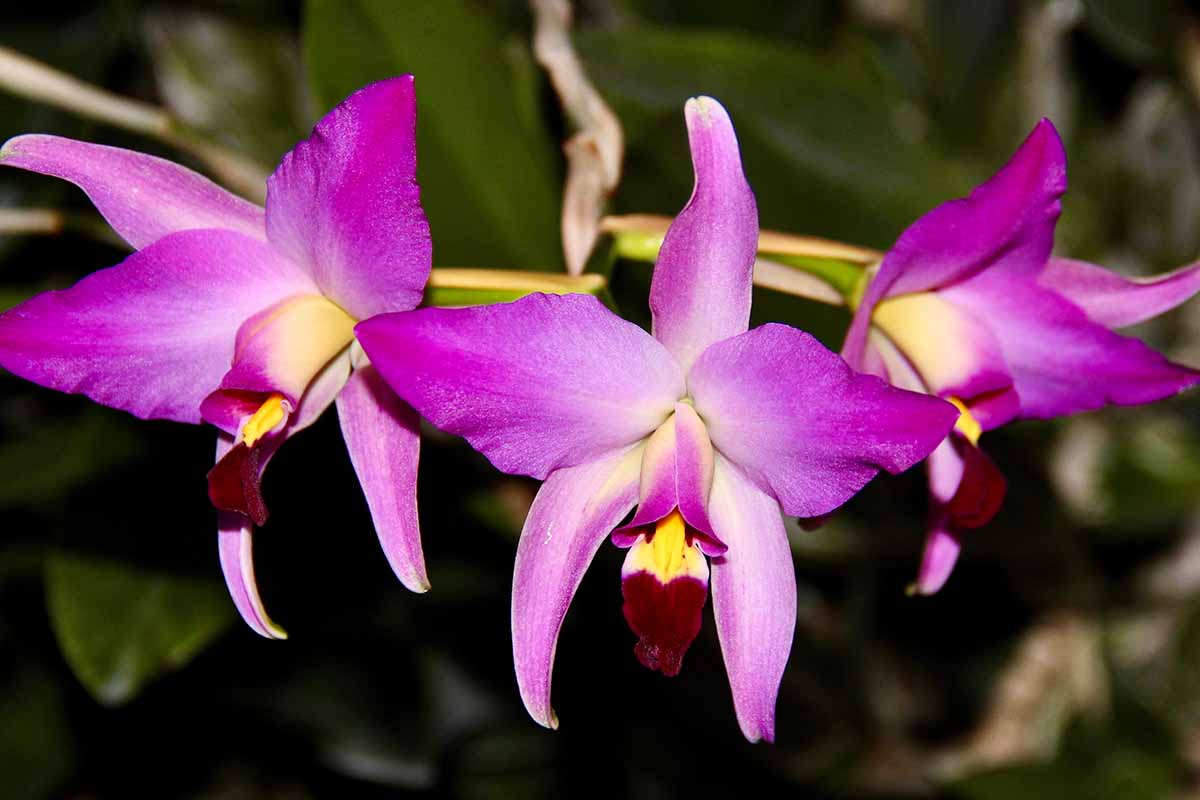
Laelias are mostly considered intermediate growers, but cultural conditions vary between different types, so be sure to check the specific requirements for your selected species or hybrid.
In general, these orchids require moderate to bright light, ample water during the growing season, and slightly drier conditions during a winter rest.
Plants should be allowed to dry out between waterings, and should be kept slightly drier after flowering. Provide 50 to 70 percent humidity.
Most laelias flourish in pots, though some are best cultivated in baskets.
Beginning enthusiasts can easily find their way to successful Laelia cultivation.
L. purpurata var. striata ‘Stars and Bars‘ x var. flamea produces clusters of three to five large flowers that are white with a bright, pinkish-purple lip and pink striping on the petals and sepals.
The flowers are five to seven inches wide, and bloom in spring or summer.

Live Laelia Hybrid Plant in 4” Pot
You can purchase a live L. purpurata var. striata ‘Stars and Bars‘ x var. flamea hybrid plant in a four-inch pot from Aloha Hawaii Orchids via Amazon.
13. Ludisia
This next option has blooms that are charming in a quiet sort of way, but it will really get your attention with its leaves.
Commonly called “jewel orchids,” members of the Ludisia genus are grown primarily for their beautifully patterned foliage rather than their flowers.
This genus contains only two species, Lus. discolor, which is native to China, Indonesia, and other parts of Southeast Asia, and Lus. ravinii, native to the Philippines.
These terrestrial or lithophytic plants are sympodial and have oval-shaped leaves that are dark green to brownish-purple with contrasting, gold to red-colored veins.
Plants reach about 10 inches tall including their inflorescences, which hold small, faintly scented, white or pink flowers.
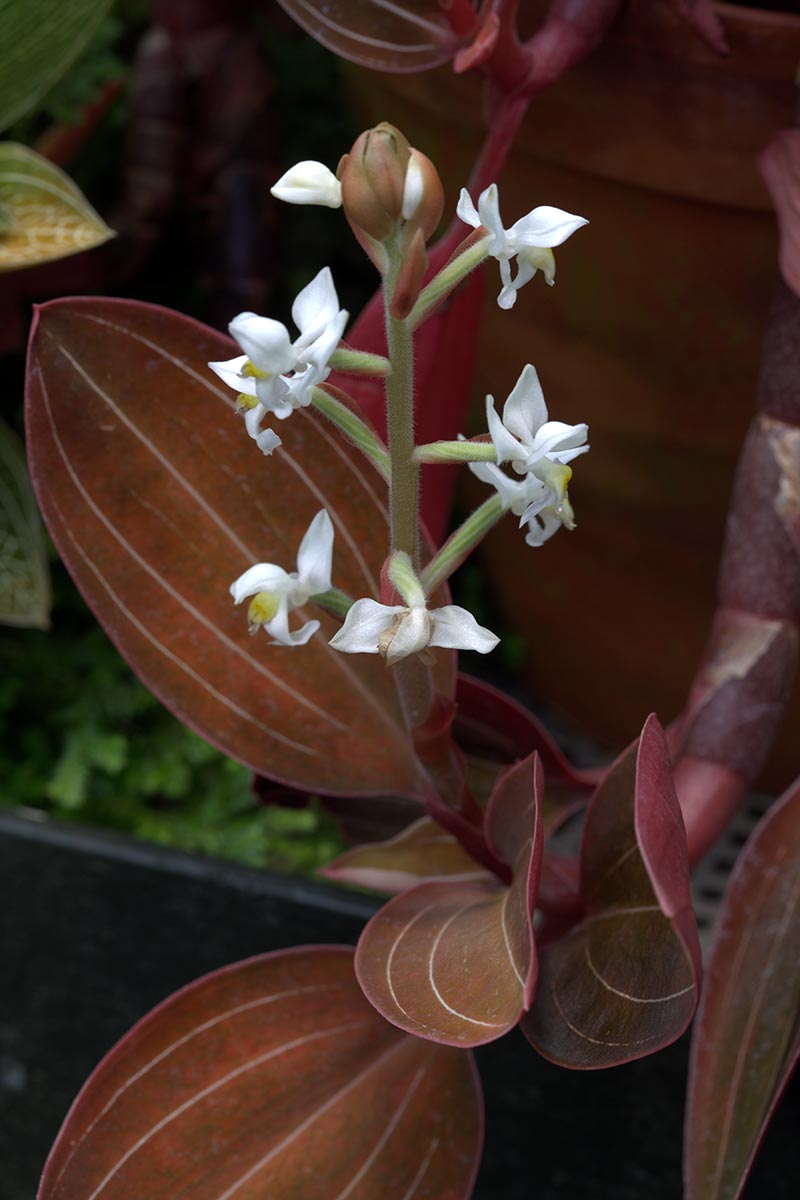
Flower spikes can be either upright or trailing, usually producing blooms during the winter months.
Jewel orchids can be cared for much like African violets, making them easy to keep as houseplants, even for beginners.
Ludisias are intermediate growers. They can be cultivated in medium, indirect light, and are easy orchids to water since they have the same requirements throughout the year.
Keep them moist, never allowing their soil to dry out all the way between waterings – they don’t have pseudobulbs to store moisture.
Ideal humidity for these orchids is in the 40 to 80 percent range, though with higher humidity, increased air flow is important.
Since they have a creeping growth habit, cultivate them in wide, shallow pots.
Lus. discolor, one of the two species in this genus, is the one you’re most likely to find to cultivate as a houseplant.
Live Ludisia Discolor Jewel Orchid Plant in 4” Pot
You can purchase a live Lus. discolor jewel orchid in a four-inch pot from Rooted via Amazon.
14. Miltonia
We’ve already encountered one star of a houseplant – here’s another.
Known for their star-shaped blooms, Miltonias hail from South America, primarily from Brazil. The genus counts just 12 species and four natural hybrids, but there are also many interspecies and intergeneric Miltonia hybrids.
Miltonia species are sympodial and produce pseudobulbs on creeping rhizomes with linear or strap-shaped leaves that are creased in the middle.
These epiphytic plants are medium-sized, reaching approximately 20 inches tall, and feature spikes of one to 12 flowers. The flowers tend to have pointy petals and sepals surrounding a large lip.
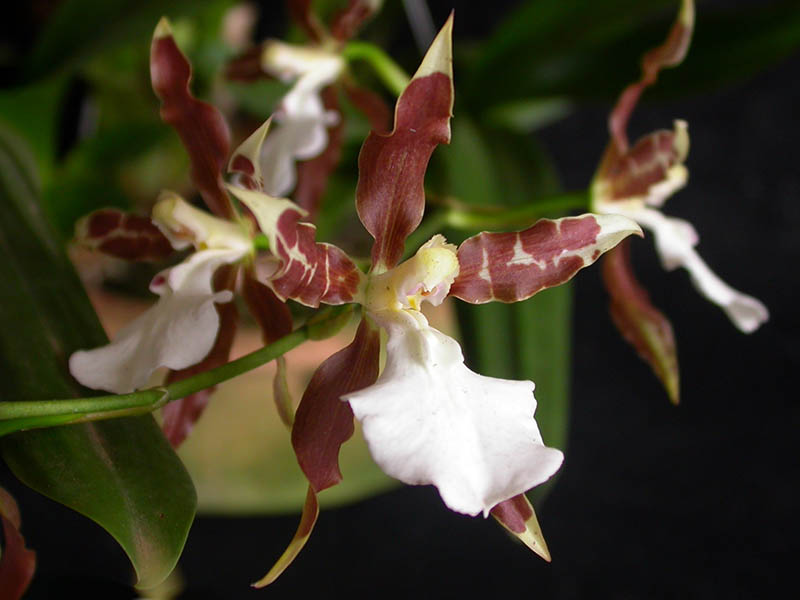
These warm growing orchids require bright light and humidity in the range of 60 to 75 percent. Their leaves will develop accordion-like folds when humidity is too low.
Miltonias need plenty of water during the growing season, and less while resting. They should be allowed to dry out almost entirely between watering.
These orchids are beginner-friendly and can be cultivated in wide shallow pots, baskets, or on mounts.

Milt. spectabilis is a good species to start with, and is available in many lovely varieties and crosses from nurseries.
15. Oncidium
Our next selection brings a warmer color palette to the houseplant table.
Known as “dancing lady orchids,” oncidiums are known for their light and airy sprays of warm-toned flowers.
The Oncidium genus contains over 330 species from Florida, Mexico, Central America, South America, and the West Indies. These originate in diverse habitats, though most are tropical or subtropical.
Also known as “golden shower orchids,” oncidiums are sympodial and have water-retentive pseudobulbs. Some types have fleshy, water-storing leaves, while others have thin ones.
Oncidiums are known for a bloom palette in yellows, browns, and maroons, and frequently have spots or splotches on their flowers.
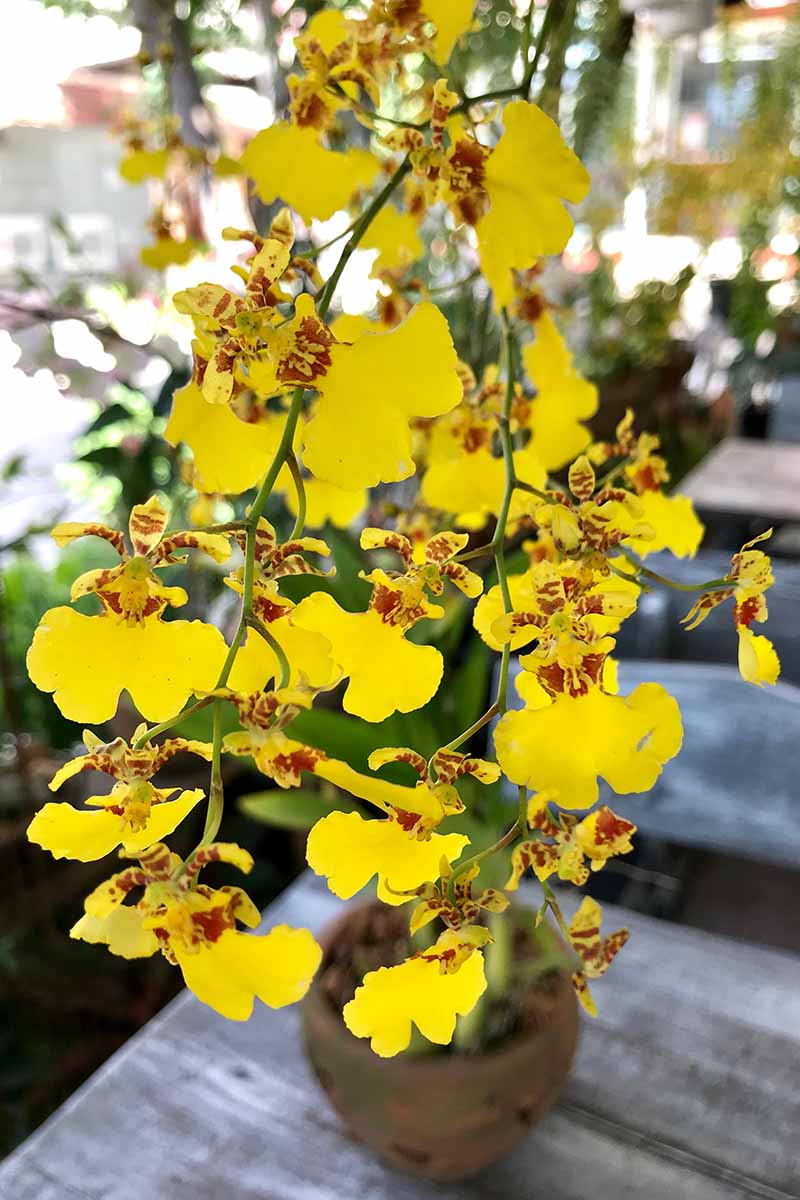
Since this is a diverse genus, growing requirements will vary from species to species and hybrid to hybrid, however, here are some general tips for caring for oncidiums:
Oncidiums are considered to be intermediate to warm growers, and require bright light, preferably with at least an hour of direct sunlight per day. Thick-leaved oncidiums can tolerate more direct sun.
As for watering, plants with thin leaves require more frequent watering than those with fleshy ones. In general, the potting medium should be allowed to dry about halfway between waterings.
Some species have a winter rest period, at which time they should be watered less.
Humidity needs for these plants range between 30 and 80 percent. Watch for accordion folds in leaves as a sign that more humidity is needed.
Species that are more drought tolerant can be mounted, while those cultivated in pots should be kept in small-sized pots to discourage root rot.
Oncidiums tend to be easy to care for, even for beginning orchidophiles.
To get started with plants in this genus, you might consider Onc. Rex’s Luck ‘Firefly,’ a slightly fragrant hybrid that has curled or wavy, purple and white petals and sepals, graced with a bright yellow spot on its maroon lip.

Oncidium Rex’s Luck ‘Firefly’ Live Plant in 3.5” Pot
You can purchase a live Onc. Rex’s Luck ‘Firefly’ hybrid in a three-and-a-half-inch pot from Orchid Insanity via Amazon. These specimens are shipped 12 to 18 months from blooming.
16. Paphiopedilum
While many orchid flowers are intriguing because of their colors or patterns, this next selection has blooms with forms as captivating as sculptures.
Paphiopedilums, called “paphs” for short, are mesmerizing orchids to behold.
To quote William Cullina, author of “Understanding Orchids,” available at Amazon, paphiopedilums “look as if they have been assembled by someone with an eccentric bent and a good eye for proportion and balance.”
I agree wholeheartedly with Cullina’s description of these astonishing flowers.
Native to tropical areas of Asia, the Paphiopedilum genus contains over 100 species. Many hybrids have been produced as well.
Also called “Venus slippers,” “lady slippers,” or “slipper orchids” in reference to the shape of the flower’s lip, paphiopedilums are usually terrestrial, but sometimes live on rocks or trees.
They are sympodial, but have no pseudobulbs, and produce a fan of three to eight leaves, which are usually short and strap shaped.
These leaves are either solid green or mottled dark and light green, and sometimes have purple undersides.
These plants tend to reach up to two feet tall, including their inflorescences.
One or more large showy blooms are produced per spike, appearing in shades of green, pink, burgundy, yellow, ivory, or umber.
Flowers often have lines, spots, and veining on the petals, sepals, and lips.
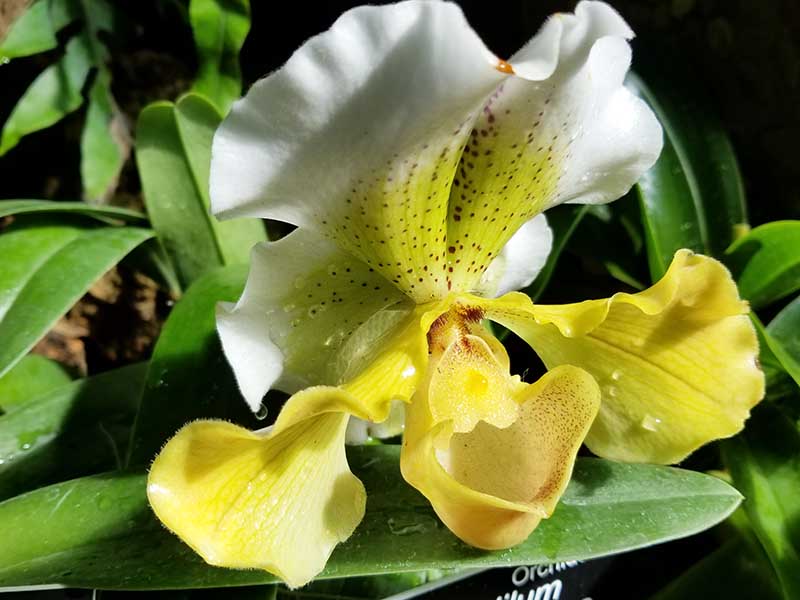
Paphiopedilums have some specific culture requirements:
As for temperature preferences, paphs with solid green leaves and one bloom per spike are temperate growers, while those that have mottled leaves, or solid green leaves with multiple blooms, are warm growers.
Paphiopedilums don’t require as much light as some orchids – only medium, indirect light is needed for these to thrive, making them good companions for prayer plants.
Since paphiopedilums don’t have water-storing pseudobulbs, they mustn’t be allowed to dry out.
The potting medium should be kept moist but not soggy, and should be watered when the surface is dry to the touch.
Lady slippers need at least 50 percent humidity, should be cultivated in plastic or clay pots, and need to be repotted yearly.
Some paphiopedilums are easy to cultivate for beginners, while others are better left to intermediate or advanced orchidophiles.
If you’re just getting started in your orchid growing pursuit, choose a mottled leaf species or hybrid, such as Paph. callosum, which will make a good houseplant.
Its blooms may be red, pink, green, white, or wine-colored.

Blooming Size Live Paph. Maudiae Hybrid in 4” Pot
Paph. Maudiae is a primary cross of two species, Paph. callosum and Paph. lawrenceanum. It has mottled foliage, and is easy to cultivate.
The Orchid Gallery sells seed-grown orchids of this cross, so you won’t know exactly what its blooms will look like until it flowers, since it’s not a clone.
You can purchase one for yourself, or for your favorite orchidophile, in a four-inch pot from the Orchid Gallery, via Amazon.
17. Phalaenopsis
While some orchids may seem as intimidating as supermodels, this next selection is more like a comfortable, reliable – but nonetheless good looking – best friend.
Phalaenopsis orchids are known as being the easiest orchids to grow, as well as the easiest to find – you may even be able to pick one up in your local supermarket!
Native to tropical and subtropical areas of Asia and Australia, the Phalaenopsis genus contains approximately 78 species, plus natural hybrids, and there are many horticultural hybrids as well.
Also known as “moth orchids,” these species are mostly epiphytic, though some are lithophytes or terrestrials as well.
“Phals,” as they are affectionately called, are monopodial with large, fleshy leaves which help to store water rather than the pseudobulbs frequently found among sympodial species. The tops of the leaves are medium to dark green, and the bottoms may be maroon.
These plants can reach up to three feet tall when you include their arching flower spikes.
Large blooms open in late winter to spring, and are typically colored in shades of white, yellow, pink, peach, or purple. These gorgeous flowers last many months, and some are fragrant.
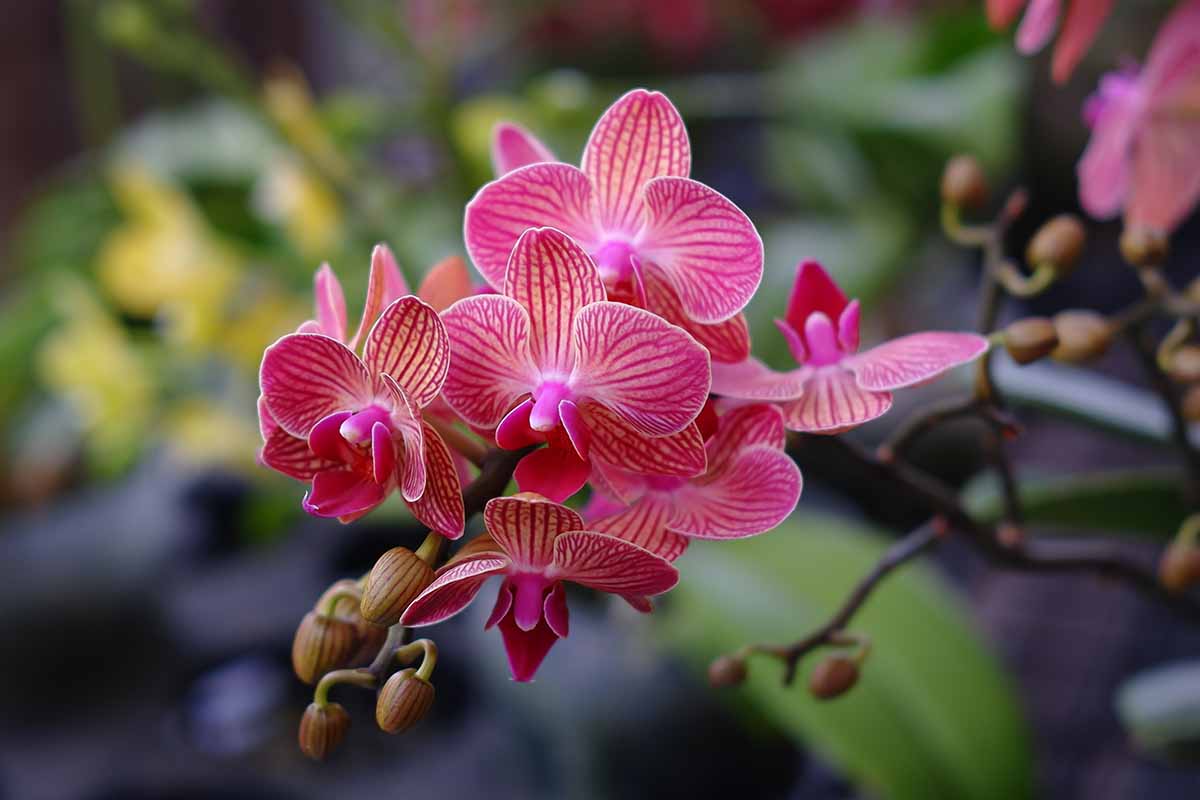
Phals are easy to cultivate in average household conditions, and are considered intermediate to warm growers.
They are also fairly flexible – provide them with low, medium, or bright indirect light and they will prosper.
One of the things that makes phals easy to care for is that they will thrive with the same level of moisture year round, not requiring the rest period that some orchids do.
Keep their potting medium slightly damp, allowing it to almost dry between waterings, and provide humidity between 40 and 80 percent.
Because of their photosynthetic roots, phals are often cultivated in clear plastic pots, but they can also be grown in baskets.
For more tips on caring for these stunning houseplants, check out our guide to growing and caring for Phalaenopsis orchids.
Phalaenopsis orchids make excellent choices for beginners, and are often sold without specific hybrid or species names attached to them.
You can purchase a live phalaenopsis with white, salmon, or purple blooms in a 10-inch pot from FastGrowingTrees.com.
18. Phragmipedium
Those who enjoy the challenge of growing moisture-loving carnivorous plants will be thrilled with this next selection.
Members of the Phragmipedium genus are, like paphiopedilums, also called “slipper orchids.”
The 20 or so species in this genus are terrestrials, lithophytes, or epiphytes and hail from Mexico, Central America, and South America.
These sympodial plants have narrow leaves arranged like a fan, and fibrous roots.
With a pouch- or slipper-shaped lip, a Phragmipedium flower looks quite similar to that of a Paphiopedilum.
Often casually called “phrags,” their blooms can be green, greenish-yellow, maroon, red, orange, or bright pink.
Along with their slipper-shaped lips, phragmipediums sometimes have narrow, twisted sepals and petals.
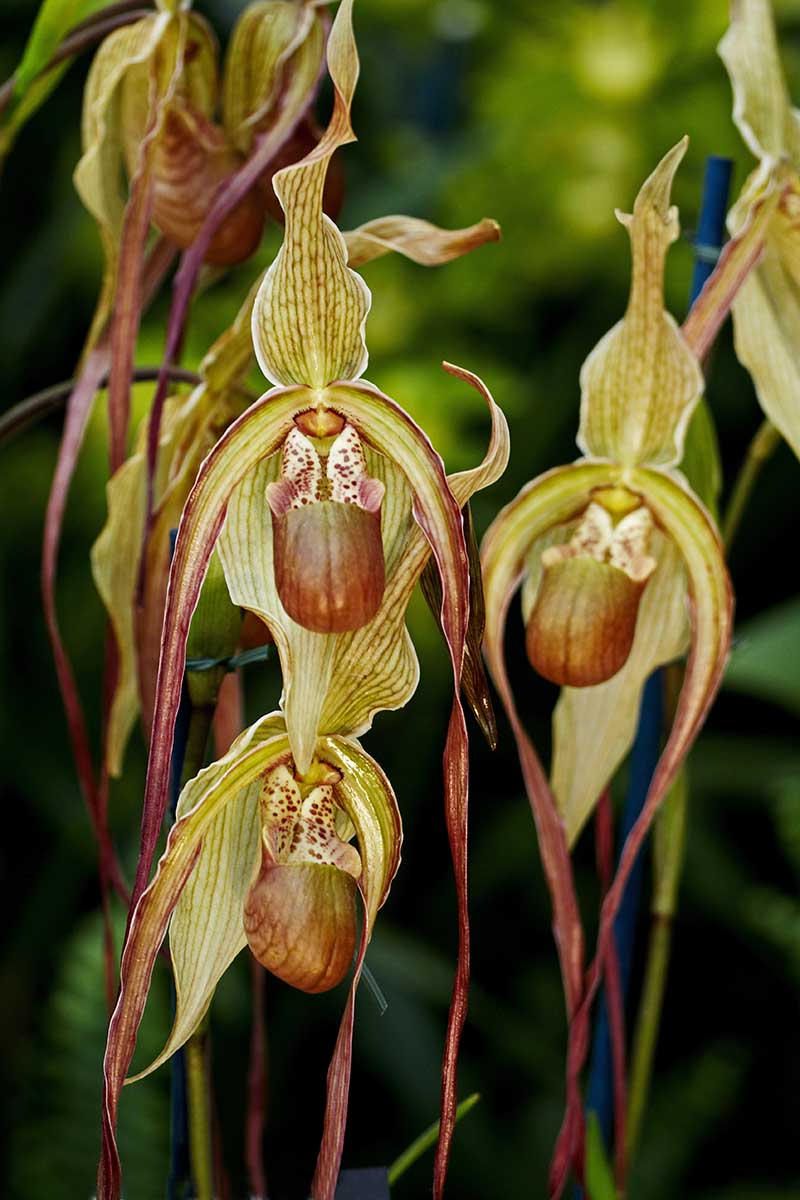
In some species and hybrids, these can reach astonishing lengths, giving the blooms a truly unique appearance.
Phragmipediums are warm to intermediate growers and require bright, indirect light.
Intermediate and advanced orchid enthusiasts will be the most successful growing phragmipediums, and that is largely due to their moisture requirements.
To say that phrags need to be kept evenly moist throughout the year is somewhat of an understatement.
Most species require a damp potting medium, and some are even grown with their pots sitting in saucers of water – a condition which would put many houseplants on the express train straight to Root Rot Central.
In addition to these particular hydration needs, these orchids also require filtered, distilled, or rainwater that has not been chemically treated, and humidity between 60 and 70 percent.
Because of their high moisture needs, these plants are cultivated in pots.
If the fascinating flowers of these moisture-loving orchids fill you with deep admiration, Phrag. caudatum is an excellent species to start with.
Phrag. caudatum tolerates warmer temperatures and is not as thirsty as its relatives, making it one of the more accessible phragmipediums to grow.
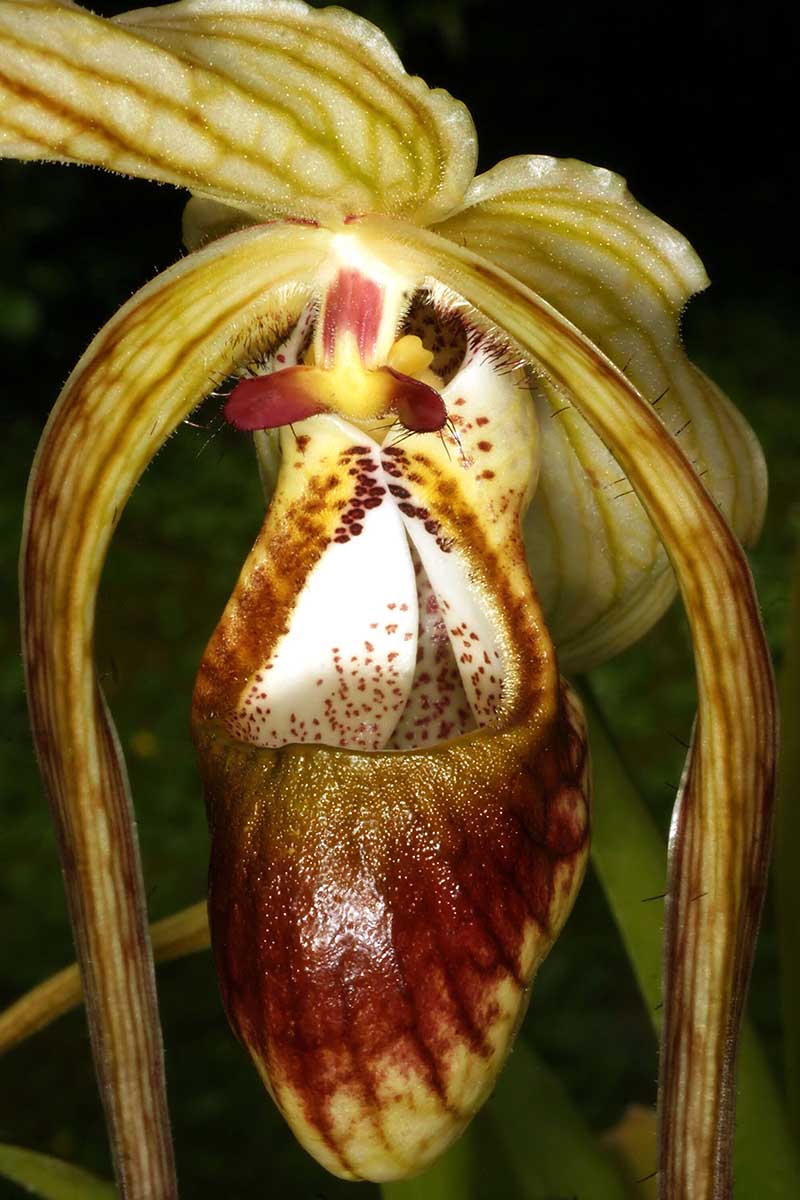
The petals on this species are staggering, reaching up to two and a half feet long.
Its impressive petals and sepals are pale greenish-yellow with a darker greenish-yellow pattern that might remind you of crackled porcelain, surrounding a ruddy, pouch-shaped lip.
19. Polystachya
If there is a Pollyanna of the orchid family, perhaps it is this next option, with its tendency towards simple, cheery-colored blooms.
Polystachya is a genus composed mostly of epiphytes, with some lithophytes, and more rarely, terrestrials.
With over 240 species, the members of this genus are native to tropical and subtropical habitats in Africa, the Americas, and Asia.
Also called “yellowspike orchids,” these small to medium-sized, compact plants are sympodial and produce pseudobulbs or reedlike stems topped with leathery, fleshy leaves. Some species are deciduous.
These plants produce spikes with many small, fragrant flowers, usually in shades of yellow, orange, white, or green. Their inflorescences last one month or longer, with some species blooming on and off throughout the year.
The flowers of these plants are non-resupinate, meaning the lip of the flower is on the top rather than the bottom, making them look as if they’re upside down compared to other orchids such as phals and oncidiums.

Most polystachyas are warm to intermediate growers and require bright to very bright light.
Those with prominent pseudobulbs have a greater water storage capacity and can go longer without water than those with reedlike stems.
While it’s best to check the moisture needs of your particular hybrid or species, as a general rule, it’s best to wait until the substrate has almost dried out before watering it.
Those that are deciduous should be watered amply during their period of active growth, but should receive a rest period (while leaves are gone) with little or no water, depending on the species.
Provide polystachyas with a humidity level of 40 to 60 percent, and cultivate them in pots or on mounts.
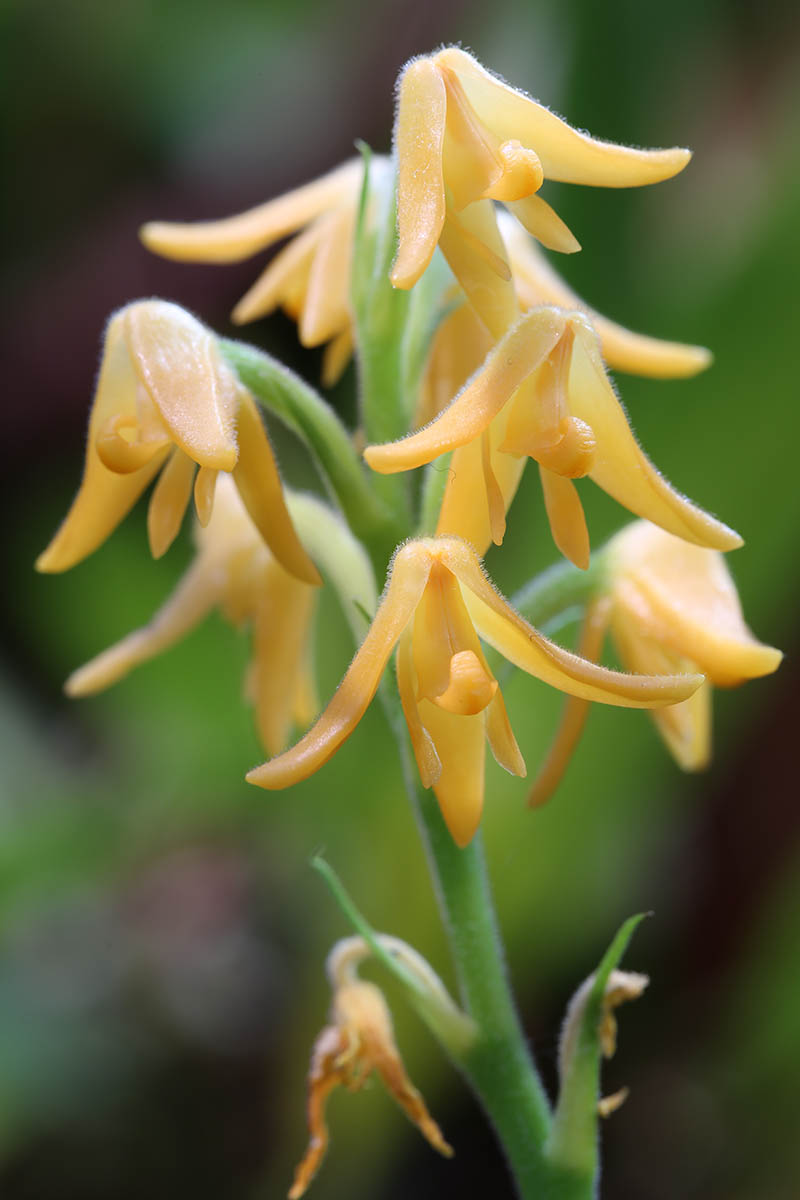
Beginners can easily grow evergreen polystachyas, but may want to avoid deciduous species until they’ve gained more experience.
A great starter species, Pol. bella bears small, fragrant, yellow flowers. This evergreen species is an intermediate to cool grower.
20. Prosthechea
If you appreciate the quirky visual appeal of cephalopods such as squid and octopi, some of these plants will be just your cup of tea.
With over 120 sympodial species, the Prosthechea genus is native to tropical zones of the Americas.
Epiphytes with elongated pseudobulbs and narrow, strap-shaped leaves, plants in this genus can be divided into two groups.
The cockleshell group has flowers that seem to be upside down, since their lips are on the tops of the blooms. The other unnamed group has lips on the bottom, and these are known for their brighter bloom colors.
These orchids have long-lasting, highly fragrant flowers that typically bloom in winter – however, some have a longer bloom period that extends into the spring or beyond.
In fact, Psh. cochleata, the “clamshell” or “cockleshell” orchid, has sequentially blooming inflorescences that can remain in flower for 12 to 18 months, making the plant seem like it is always in bloom!
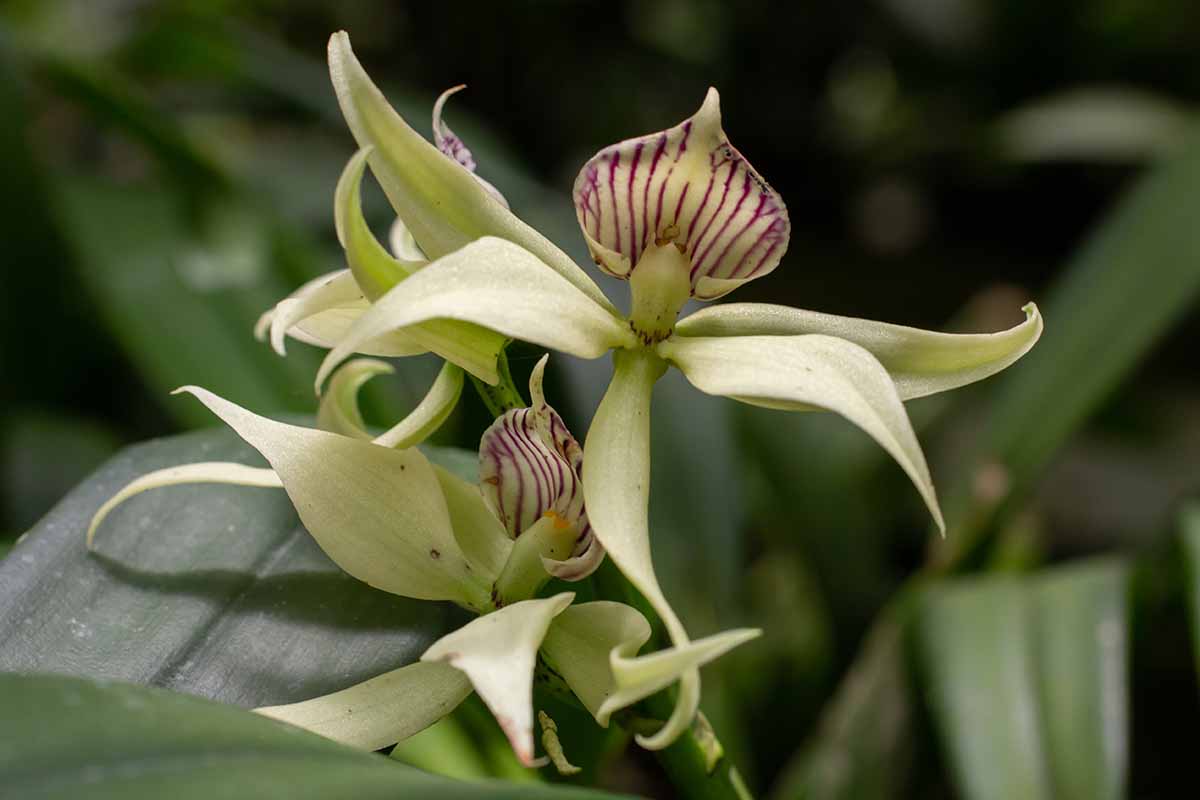
Prosthetcheas are intermediate growers, but they can tolerate higher temperatures well.
They should be grown in bright indirect light, with good air circulation and moderate to high humidity, between 40 and 85 percent.
While the growing medium of cockleshell types should be kept moist (but not soggy) for most of the year, plants in the other group should be given a drier rest period during the winter.
Cockleshells should be cultivated in baskets filled with moss or bark, and the others can be grown on mounts, in baskets, or in pots. Both types are considered great options for the beginner enthusiast.
Psh. radiata, formerly classified as Encyclia radiata, makes an excellent choice for a starter plant.
It is a fast grower that bears coconut-scented blooms in the spring. The flowers are cream colored with an upside-down lip that is striped with purple.

Live Prosthechea Radiata in 4” Pot
You can purchase a live Psh. radiata orchid in a four-inch pot from Aloha Hawaii Orchids via Amazon.
21. Rhynchostylis
Orchids that hold up large, individual blooms for us to admire are certainly the reason most of us are attracted to plants in this family.
But let’s not overlook those that offer full, thick sprays of small blooms.
Known as “foxtail orchids,” there are only five species within the Rhynchostylis genus, and they all hail from Asia.
These tropical orchids are epiphytic or lithophytic, exhibit monopodial growth, and have fleshy, leathery, strap-shaped leaves.
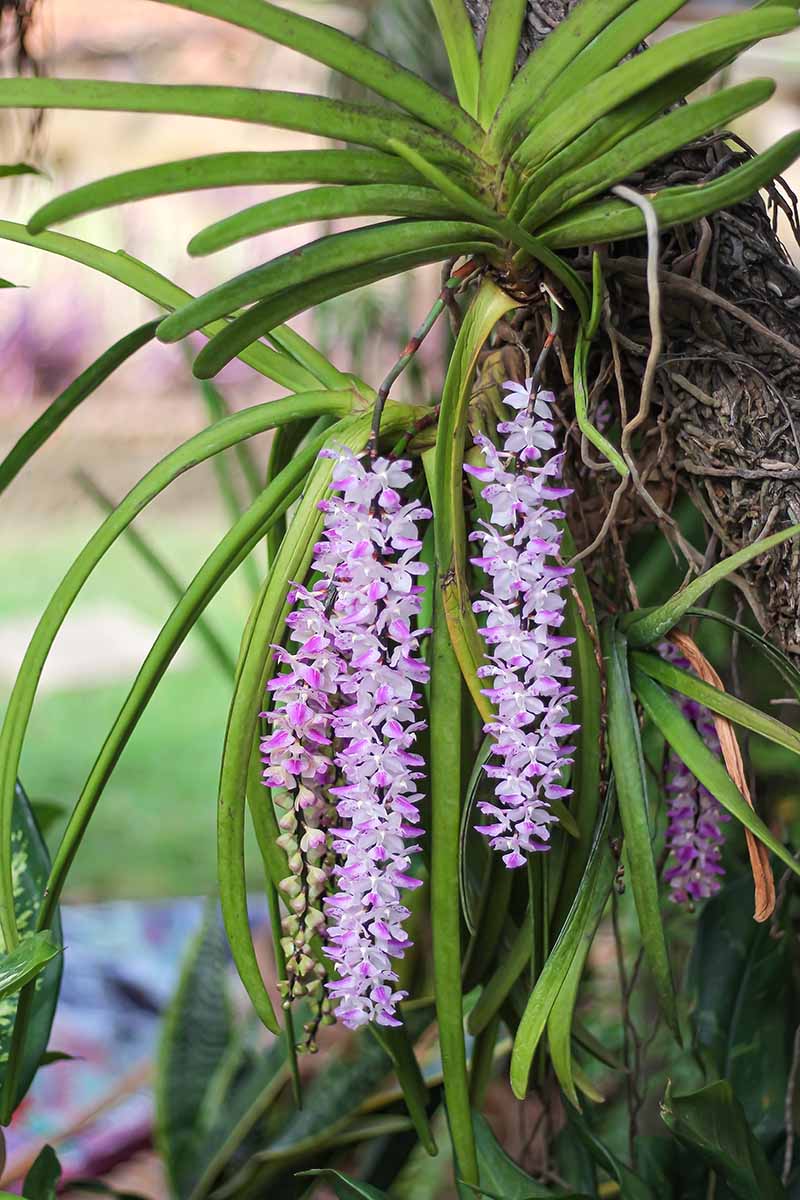
Their flower sprays are arching or pendant and bear showy, highly fragrant flowers in shades of white to magenta, often with bold red or purple spots.
Here are a few tips for growing rhynchostylis orchids:
These intermediate to warm growers require bright, indirect light with humidity around 75 percent, and should be watered daily if grown in baskets or mounted.
For specimens cultivated in pots, water when the medium has just started to dry out. The exception to this is with specimens in flower, at which time the growing medium should be kept moist.
These orchids need a drier rest period outside of the growing season, and are traditionally grown in hanging baskets or mounted.
Because of their somewhat involved cultural requirements, beginning growers may want to hold off on experimenting with these until they have gained more experience with the orchid family.
But if you’re looking to get your feet wet with something in the Rhychnostylis genus, why not start with Rhy. gigantea?
Rhy. gigantea bears a trailing flower spike covered with fragrant white flowers that have pink to purple markings and a pink lip.
Blooms appear in winter, continually flowering for up to three months. This species is a warm grower that can be cultivated either in a pot or an orchid basket.
Live Rhynchostylis Gigantea 1-2 Year Old Plant
You can purchase a live one- to two-year-old Rhy. gigantea orchid from Planterest via Amazon.
22. Vanda
While I promised you a list of orchids you can grow indoors as houseplants, Vandas are much better suited to being cultivated in greenhouses.
But any respectable list of popular orchid selections would be lacking if it didn’t include this member of the family!
Hailing primarily from low-altitude areas in the subtropics and tropics, the Vanda genus consists of 85 species native to Australia and Asia.
These monopodial orchids have large, aerial roots and grow on trees or rocks in the wild. Typically tall plants with the largest species reaching six feet in height, some grow to a mature stature of only a few inches.
Leaf type varies among vandas. Some are strap shaped and leathery, others have terete (pencil-shaped) leaves, and some have semi-terete leaves. In general, the foliage has a medium green hue.
Blooms are usually large and showy, ranging from one to six inches wide, appearing in a vast array of colors and sometimes featuring a checkerboard or mosaic pattern, or spots.
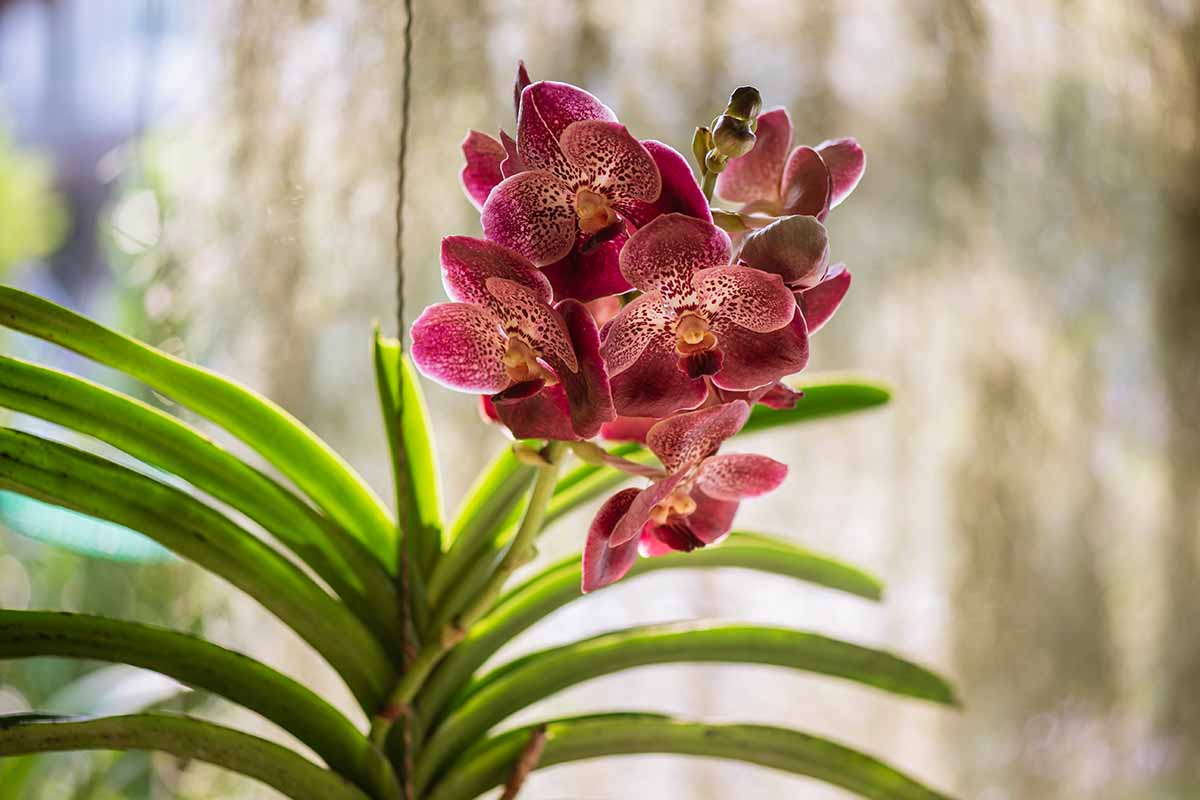
Vandas can bloom at any time of the year, with flowers that can last anywhere from a couple of weeks to a couple of months, and some have fragrant flowers.
At their best when grown in greenhouse conditions, you may be able to cultivate them successfully as houseplants if you can replicate the intense light and high humidity more typical of a greenhouse.
If you are an advanced orchid grower ready for a challenge, here’s what you’ll need to know to successfully care for vandas:
Most vandas are intermediate to warm growers, and they can tolerate daytime temperatures up to 95°F.
Vandas need bright, intense light. Those with pencil-shaped leaves need up to six hours a day of direct sun, while those with strap-shaped leaves should not receive direct sun at midday.
Vandas tend to grow poorly in pots and so are usually placed in slatted baskets where their roots will live in airy conditions and their bloom spikes can trail down.
They will need to be watered or misted often, and grow best in 80 percent humidity.
Watering several times each day may be required in warm weather, but irrigation should be less frequent when conditions are cooler.
If you’re ready to welcome home your first vanda, V. Pachara Delight is a lovely hybrid option to start with.

Live Blooming-Size Vanda Pachara Delight Plant
This hybrid has non-fragrant, deep bluish-purple flowers that have a tessellated pattern, and bloom in spring, summer, or fall.
You can purchase a live, blooming-size Pachara Delight vanda via Amazon.
23. Zygopetalum
The blooms of our last selection are quite eclectic looking, with many different colors and patterns combined like collages or patchworks.
Native to South America, the 15 or 16 members of the Zygopetalum genus are large, sympodial epiphytes or terrestrial plants.
They produce pseudobulbs with fans of strap-shaped leaves, and their foliage is very light green, with lighter veining.
The blooms of these orchids range in size from small to large, and are usually green with maroon patterns, with a large lip in a contrasting color.
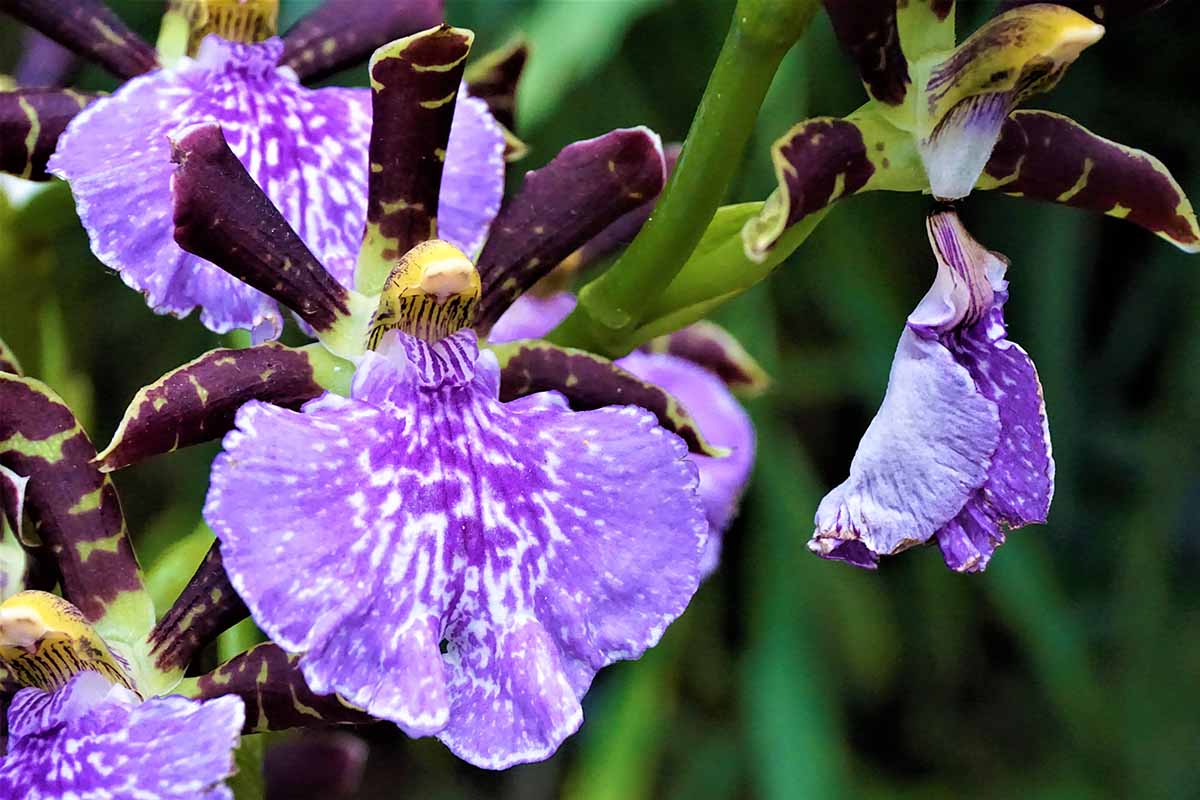
Flowers are fleshy, frequently featuring leopard-like spots, and bloom in winter or early spring. Some of them are fragrant.
Zygopetalums are intermediate growers and they prefer bright indirect light, though some direct sunlight is fine early in the morning or late in the day.
Humidity should be at least 50 percent and the potting medium should be kept slightly damp. They need plenty of water while actively growing, less while at rest.
Zygopetalum orchids will need fairly large pots to contain their large root systems.
These plants are fairly straightforward to take care of, making them suitable for beginners, and compact hybrid cultivars such as Z. Redvale ‘SD-2’ make an accessible entry into this genus.
Flowers last for two to three months and appear in fall, winter, or spring.
Z. Redvale ‘SD-2’ produces fragrant, three-inch blooms that are green and maroon with a purple and white lip.

Live Blooming-Size Zygopetalum Redvale ‘SD-2’
You can purchase a live, blooming-size Z. Redvale ‘SD-2’ from Kawamoto Orchids via Amazon.
Matchmaker, Matchmaker, Make Me a Match
Before I ask you if you’ve found your perfect orchid match, let’s review some of the options.
Looking for a specimen that can handle the same care routine year-round? Choose a Brassavola, Epidendrum, Ludisia, Paphiopedilum, or Phalaenopsis.
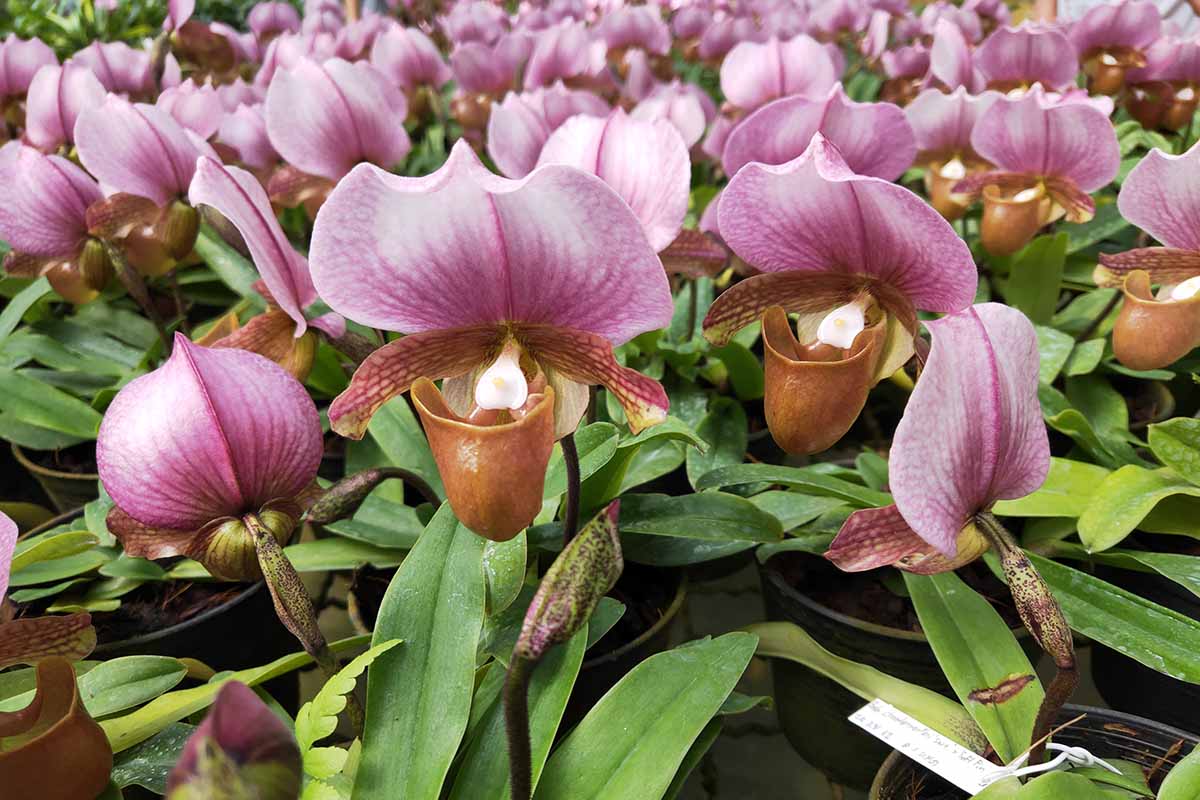
Is your relative humidity on the low side? Choose a Brassavola, Calanthe, Phalaenopsis, Polystachya, or Zygopetalum.
Are you looking for a specimen that can handle really bright light such as that found in a south-facing sunroom? Consider a Cycnoches, Oncidium, Polystacha, or Vanda.
Or are you looking for a standout houseplant that will thrive in bright, indirect light?
Take your pick among Brassavola, Brassia, Bulbophyllum, Cattleya, Cymbidium, some Dendrobium, Coelogyne, Encyclia, Epidendrum, Laelia, Miltonia, Calanthe, Phalaenopsis, Phragmipedium, Polystacha, Prosthechea, Rhynchostylis, or Zygopetalum.
Perhaps you are hoping for a specimen that can flourish with only moderate light? If so, put Bulbophyllum, Coelogyne, Laelia, Ludisia, Paphiopedilum, and Phalaenopsis on your short list.
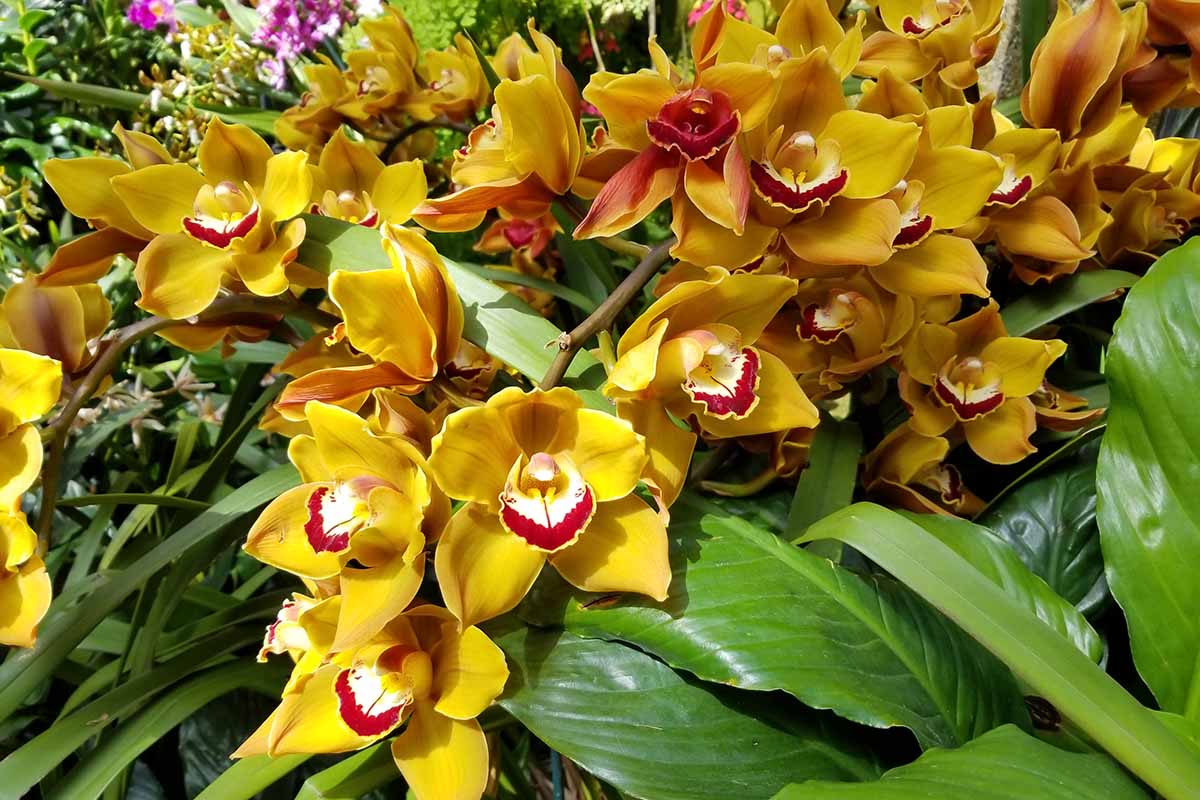
Now that we’ve reviewed how to use some of these options in your home, tell me, did you meet your perfect orchid match?
On the other hand, if you are simply trying to figure out what type you already have and need some help, let me know in the comments section below. Be sure to share a photo or two, including at least one showing the plant’s foliage!
And for more information about growing and caring for orchids, you might enjoy perusing these articles next:
